Physical Address
304 North Cardinal St.
Dorchester Center, MA 02124
Arthritis is the destruction of articular cartilage. Approximately one fourth of the human population will develop foot pain during their lifetime, and a significant percentage of this is due to arthritis.
Several types of arthritis exist: osteoarthritis or degenerative joint disease, posttraumatic arthritis, inflammatory arthritis, crystal-induced arthritis, seronegative arthritis, septic arthritis, and others. Osteoarthritis is, by far, the most common type.
Arthritic joint disease has affected man from the beginning. The 3300 bc Ötzi Ice Man, found high in the Alps between Austria and Italy, had arthritic joints. Older human specimens dating to 4500 bc show evidence of arthritis, and even prehuman Neanderthal specimens demonstrate changes consistent with arthritic disease.
One early treatment for arthritis was made from the bark of the willow tree. The active ingredient was later isolated from the bark and named salicin. In 1853, Charles Gerhardt discovered a method to buffer salicin, forming acetylsalicylic acid, which reduced the gastrointestinal side effects. While working for Bayer in 1897, Felix Hoffmann and Arthur Eichengrun further purified acetylsalicylic acid. Hoffman used it to help his father, who was suffering from arthritis. Bayer patented and successfully marketed this compound as “aspirin.”
Further discoveries continue to elucidate the various causes of arthritides. Nine genes have recently been linked to the degenerative form of arthritis. In addition, all cartilage degeneration appears to have the final common mechanism of chondrocyte apoptosis (programmed cell death), regardless of the type of arthritis. Likewise, treatment of arthritis has gone far beyond aspirin. However, there remains much to learn in the diagnosis and treatment of this significant disease.
Osteoarthritis, or degenerative joint disease, is the most common of all the arthritides. Its prevalence increases exponentially as we age; by age 65 years, 80% of the U.S. population is affected. The prevalence of osteoarthritis is second only to cardiovascular disease.
Osteoarthritis of the foot and ankle occurs in all age groups. It occurs in middle and later years as primary idiopathic osteoarthritis ( Fig. 21-1 ) and in a younger population after trauma ( Fig. 21-2 ).
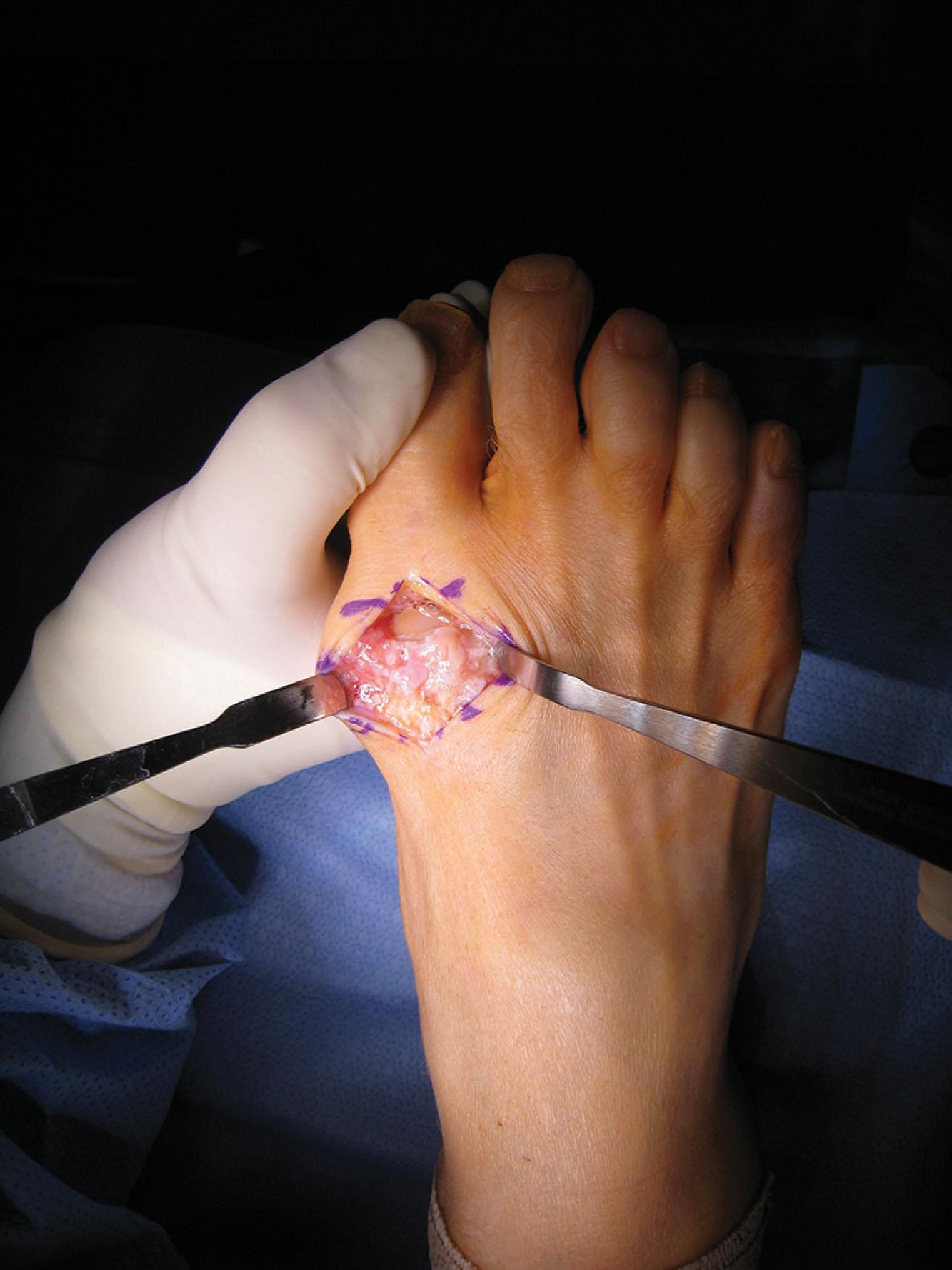
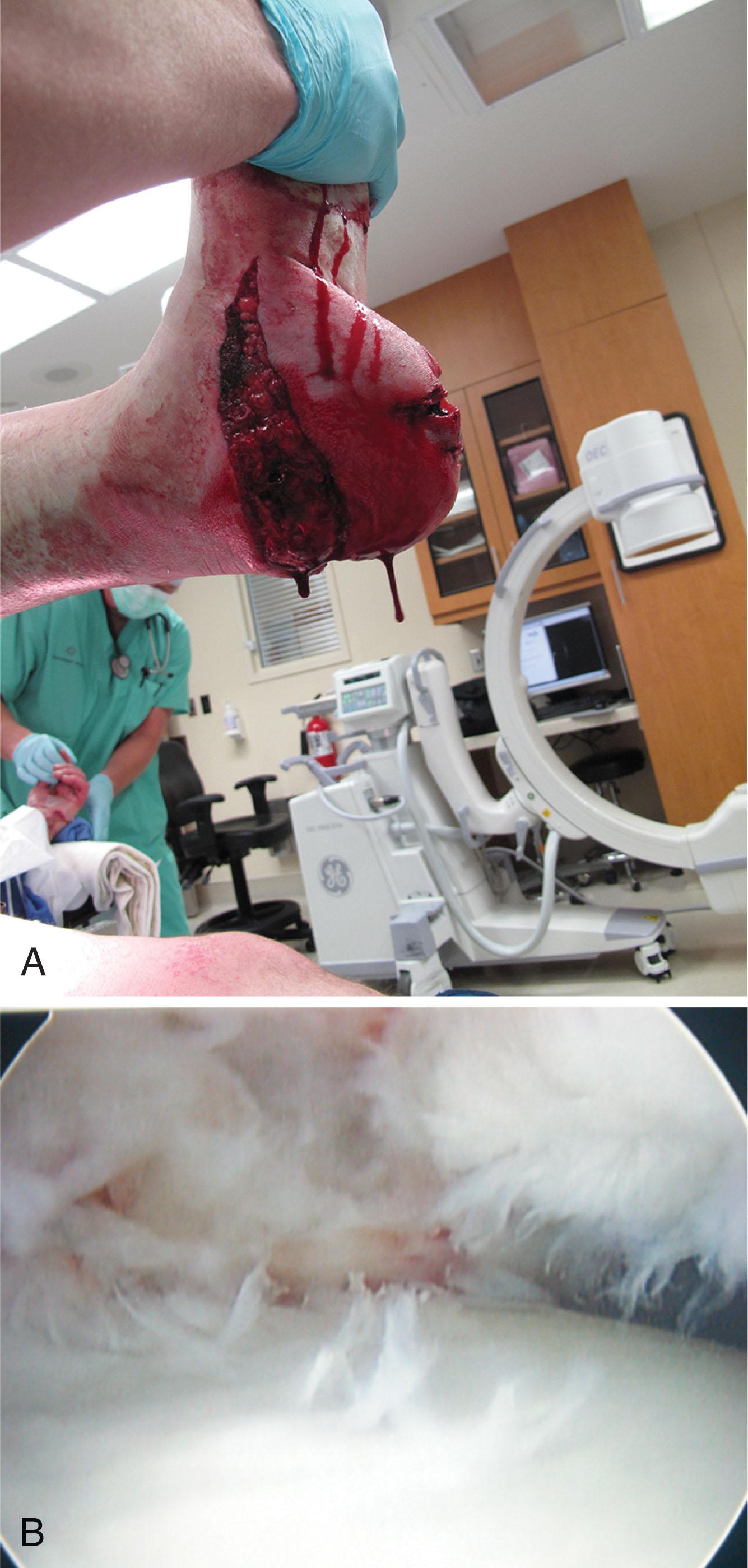
Other causes of secondary arthritis include obesity, hemochromatosis, ochronosis, and Ehlers-Danlos syndrome. Factors that can affect the onset and progression of arthritis include physical activity, occupation, and genetic predisposition. Despite advances in modern medicine, the precise etiology of arthritis remains unknown. No current treatment has been shown to completely halt its progression.
The disease is characterized by an inherent defect in the chondrocytes and the cartilage matrix they produce. Early in the course of disease, chondrocytes multiply in number. Later they produce interleukin-1 (IL-1) and tumor necrosis factor (TNF), which inhibit the formation of proteoglycans and type 2 collagen. This in turn leads to degeneration and thinning of the cartilage layer. Nine genes are now known to be linked to the osteoarthritic process, including GDF5 on chromosome 7 and MCF2L on chromosome 13.
Despite some reports to the contrary, the cytokine production mentioned above stimulates an inflammatory cell response, and inflammatory cells are found within the joint. Once this cascade begins, water content in the cartilage layer increases while the concentration of proteoglycans decreases. Grossly, the cartilage surface becomes soft and friable, and it begins to fissure.
Microscopically, the normally smooth cartilage surface shows cracks and thinning. The synovium becomes fibrotic and hyperemic, with chronic inflammatory cell infiltration. With addition of repeated mechanical trauma, fragments of articular cartilage may break off into the joint, forming loose bodies ( Fig. 21-3 ).
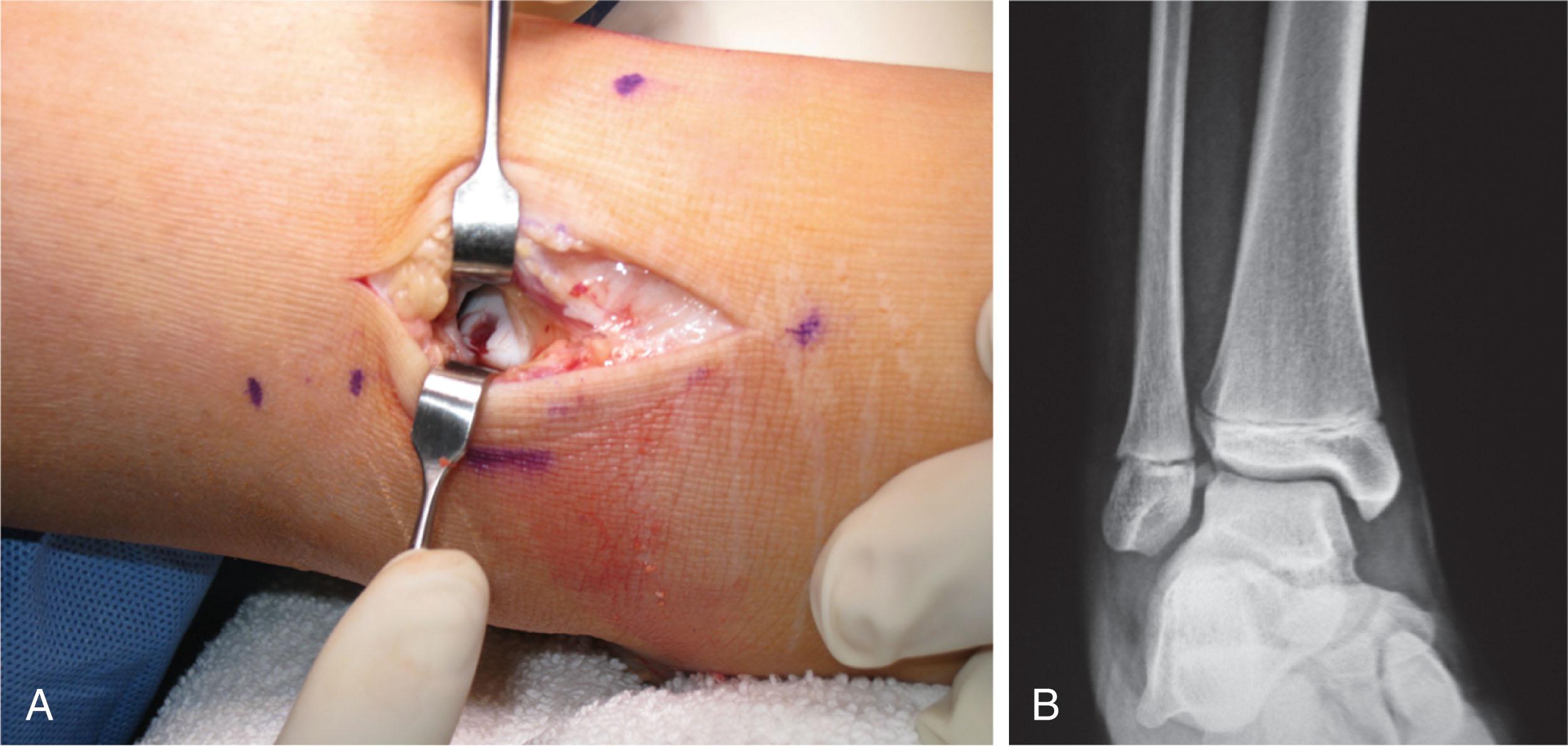
Eventually, the subchondral bone may be exposed, and a polished, eburnated bone surface is created. Crevices in the bone can form, which allows synovial fluid to penetrate the surface, forming subchondral cysts. Osteophytes form on the periphery of the joint. It is the cartilaginous and bony destruction that results in restricted range of motion, pain, and loss of function.
The history elicited from a patient with osteoarthritis varies depending on the number and location of joints involved. Many persons note morning stiffness with deep, dull pain. Typically, symptoms are aggravated by walking, standing, or physical activity and decrease with rest. Some report constant pain as well as muscular weakness. As the day progresses, the pain typically worsens.
Physical examination often demonstrates swelling around the affected joint with restricted motion. Surrounding bursae may become inflamed. Crepitation is sometimes present, and with forced motion, pain may be elicited. Periarticular osteophytes are often obvious to palpation and may cause numbness because of compression of an overlying nerve (e.g., deep peroneal nerve coursing over dorsal first tarsometatarsal [TMT] joint) ( Fig. 21-4 ). Skin ulcerations or callosities may develop on the plantar tarsometatarsal joints because of longitudinal collapse of the arch of the foot.
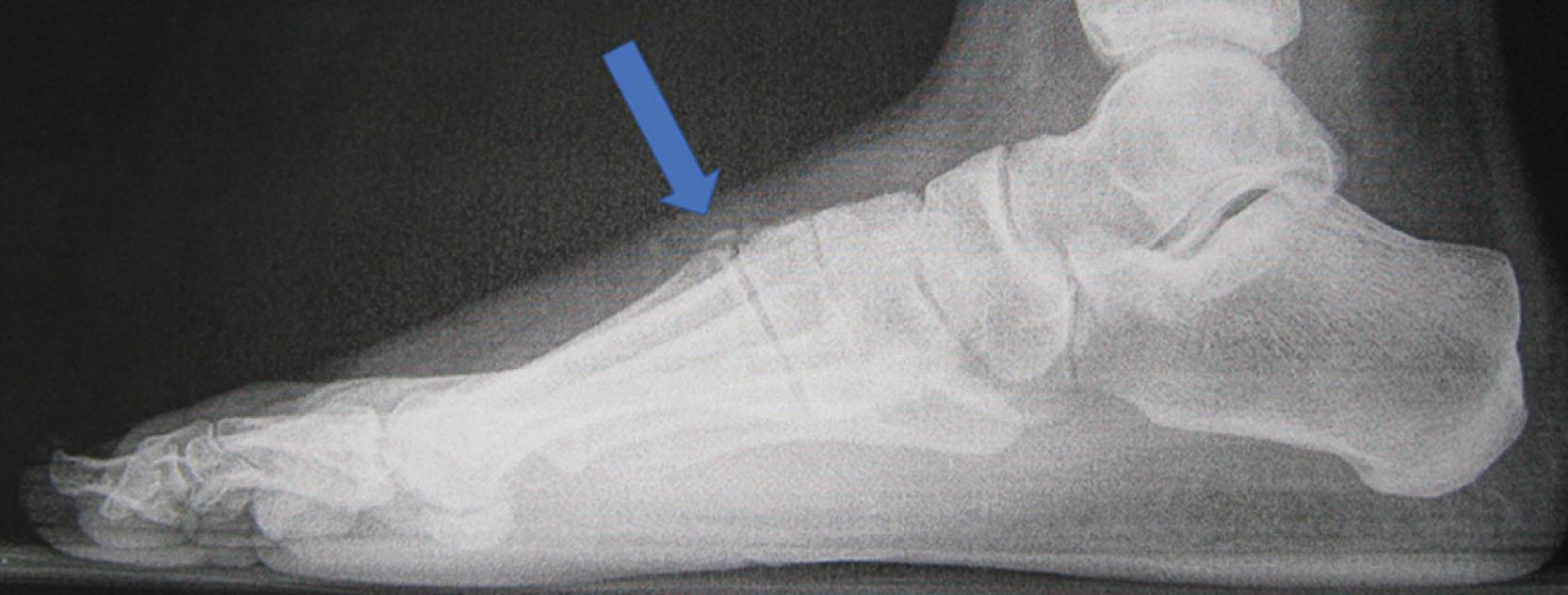
Typical radiographic findings include joint space narrowing, subchondral sclerosis, subchondral cyst formation, intraarticular loose bodies, periarticular osteophytes, and loss of normal foot alignment. These findings are best demonstrated on weight-bearing radiographs ( Fig. 21-5A ).
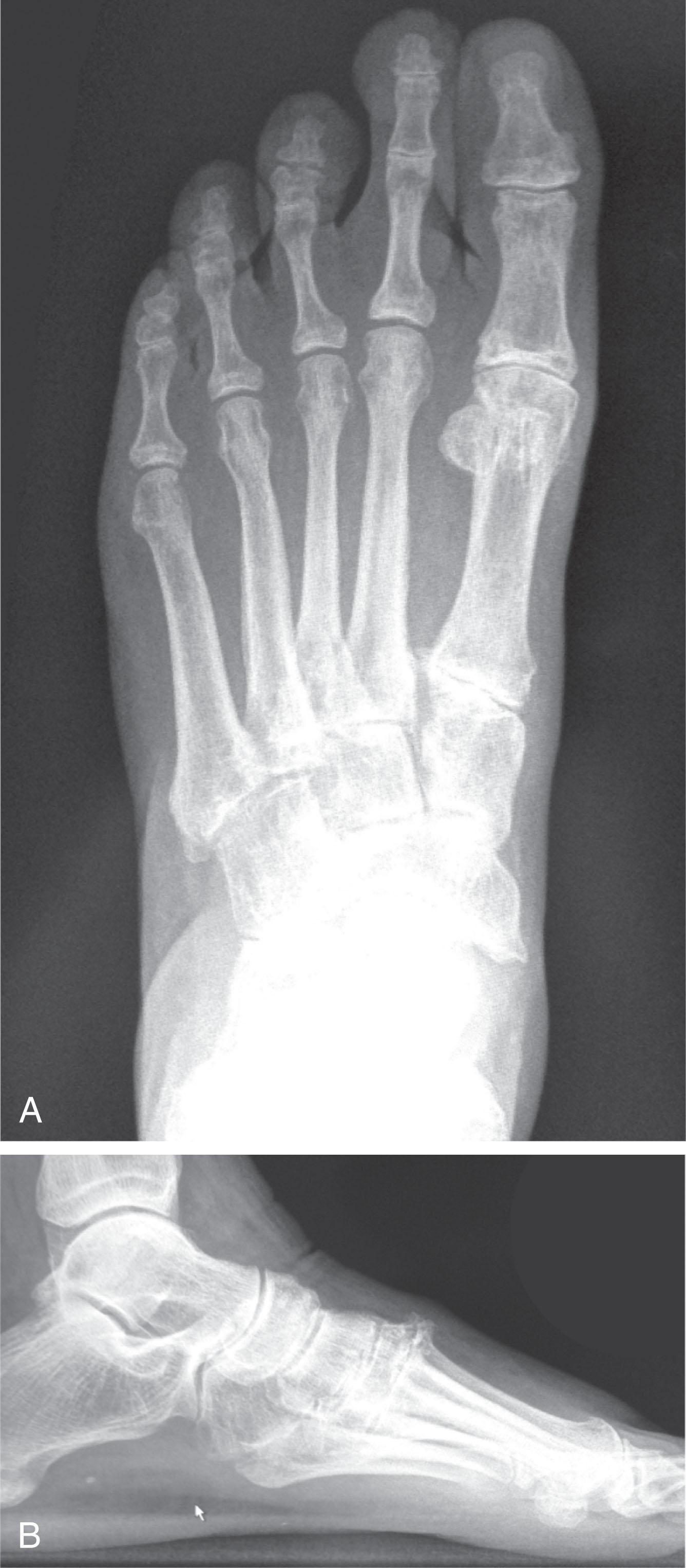
Brodén views are helpful for detecting arthritis of the subtalar joint. Naviculocuneiform and tarsometatarsal joint arthritis can be accompanied by a loss of the Meary angle ( Fig. 21-5B ). Calcaneocuboid arthritis is best seen on a medial oblique foot radiograph. Menz and colleagues noted that osteoarthritis is readily diagnosed on anteroposterior (AP) and lateral radiographs and that these findings show good interobserver reliability. Periarticular bone loss and osteoporosis, as seen with rheumatoid arthritis, rarely occur. Magnetic resonance imaging (MRI) may show cartilage thinning and signal change on T2-weighted imaging in the subchondral bone. When subtler forms of arthritis are suspected, computed tomography (CT) is useful to document the severity and extent of the disease.
Roddy and Menz noted that the first metatarsophalangeal (MTP) joint shows the highest prevalence of osteoarthritis, followed by the second tarsometatarsal joint and talonavicular joints.
Van Saase et al noted the prevalence of first MTP joint arthritis to be 28%, lesser MTP joints to be 8%, and the proximal interphalangeal (IP) joints to be 7%. The radiographic prevalence of midfoot and hindfoot joint arthritis has not been reported.
Conservative treatment methods, such as weight reduction and activity modification, may reduce symptoms. Thus, manual laborers who develop arthritis of the foot or ankle may experience pain reduction with more sedentary occupations. Although rest is often advocated, animal studies have shown that increased activity diminishes the symptoms of arthritis and may slow its progression. Cross training and lower impact activity may also be beneficial to reduce stress on affected joints while maintaining joint mobility (i.e., joggers may substitute cycling or swimming).
Over-the-counter footwear or prescription footwear can reduce symptoms over bony prominences. Orthoses can support unstable areas and areas with rigid deformities. Semiflexible orthoses appear to be better tolerated than rigid orthoses in treating degenerative joint disease of the hindfoot and midfoot. Orthoses that may be considered include ankle–foot orthoses (AFOs) for ankle, hindfoot, and midtarsal deformities; rocker-bottom shoe modifications for decreased ankle, hindfoot, and forefoot motion; molded-leather ankle braces for hindfoot arthritis; and custom-made and prefabricated orthoses for midfoot and forefoot problems. The University of California Biomechanics Laboratory (UCBL) brace is designed to limit the motion of the subtalar joint.
Nonsteroidal antiinflammatory drugs (NSAIDs) are often used as first-line pharmacologic treatment. However, concerns remain regarding potential gastrointestinal, renal, and cardiac side effects. All NSAIDs have been linked to an increased cardiac risk.
Intraarticular corticosteroid injections can provide significant and sometimes prolonged clinical relief; however, the American College of Rheumatology recommends waiting at least 3 months between injections. Several studies have noted efficacy for up to 2 years, yet many patients experience much shorter relief. This difference is poorly understood. In larger joints, synovial fluid aspiration before steroid injection may increase effectiveness and duration and may reduce clinical relapse. Side effects include periinjection lipodystrophy; skin atrophy; postinjection flare-reaction (1%–10% of patients), thought to be caused by the crystalline preparation of the steroid); and facial flushing (15% more common in women). The most common adverse event with subtalar joint steroid injections are flare reactions at 5.8%. Infections are extremely rare.
Prolonged steroid use has many side effects, including hypothalamic-pituitary axis suppression and hepatic gluconeogenesis, which worsens glucose intolerance among diabetics. Intraarticular injections have far less systemic side effects than oral preparations, and the effect is usually transient.
Contraindications to intraarticular steroid injection include preexisting septic arthritis, surrounding cellulitis, injection into a prosthetic joint, preexisting fracture, or coagulopathy. Although septic arthritis has been reported after intraarticular injection (1 in 3000 to 1 in 50,000 in the knee ) the risk is small with appropriate skin preparation and technique. Cartilage degeneration after high doses and duration of intraarticular steroid injections has been noted in animals. Whether intraarticular steroid injections cause a progression of arthritis in humans is controversial. However, steroids may be effective regardless of the type of arthritis. Preoperative fluoroscopic-guided injections ( Fig. 21-6 ) may help determine which joints may be improved by arthrodesis. With tarsometatarsal joint injections, the anesthetic/steroid mixture may leak to adjacent tarsometatarsal joints in up to 20% of cases.
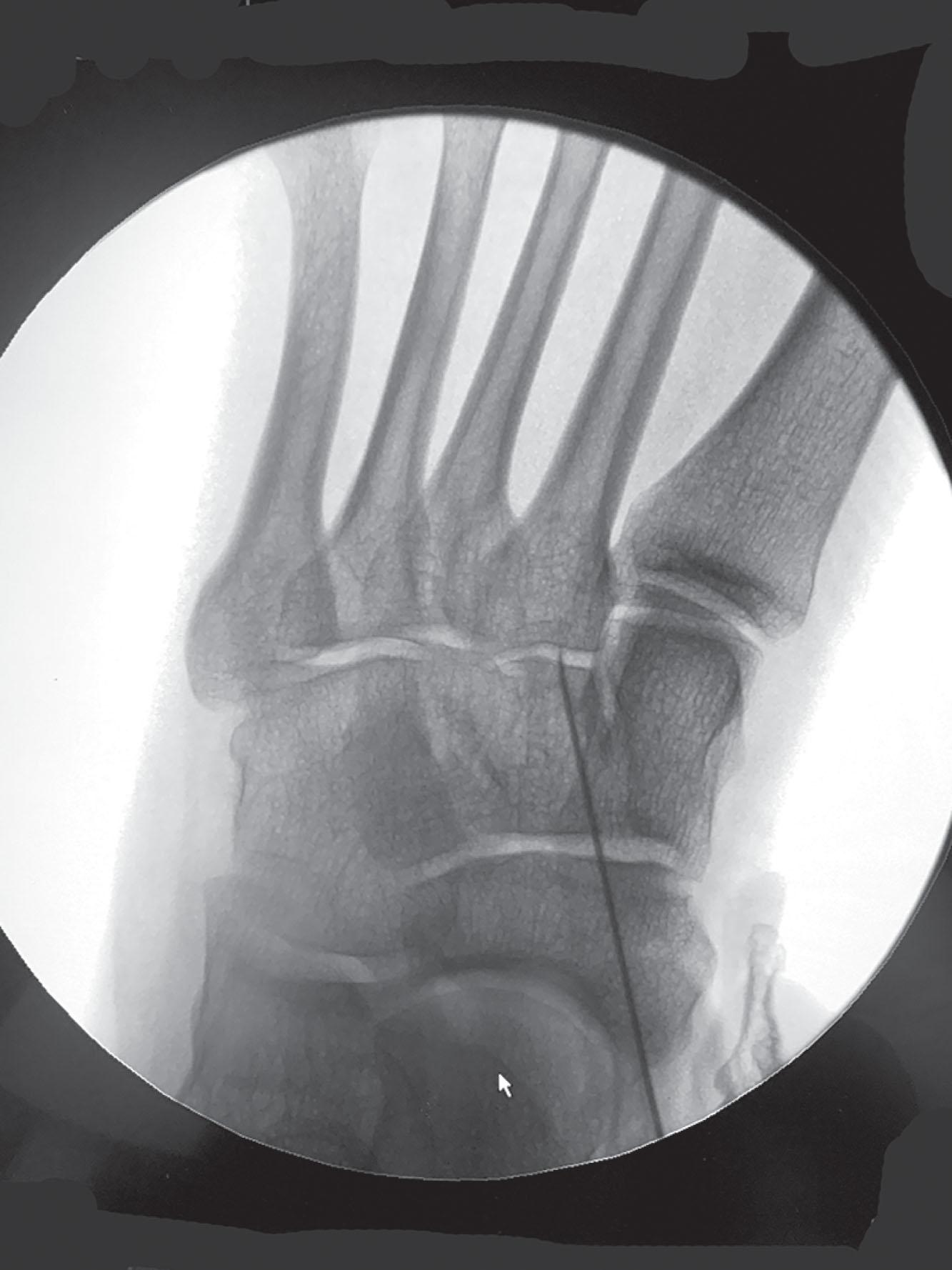
To date, there are no pharmacologic agents known to halt cartilage destruction or restore the cartilage matrix. However, Sampson et al demonstrated that teriparatide (Forteo), a recombinant parathyroid hormone, increases proteoglycan content and inhibits cartilage degeneration in mice. Although this drug is used to treat osteoporosis, further studies may reveal other applications.
The primary surgical indication for degenerative arthritis of the foot or ankle is intractable pain or deformity that is not relieved with local or systemic pharmacologic treatment or biomechanical aids, such as immobilization or bracing. Surgical techniques vary from arthrodesis to excisional arthroplasty to osteotomy. Joint implants, in general, have been disappointing in the forefoot and hindfoot (see later discussion of first MTP implants).
The hindfoot comprises the subtalar, talonavicular, and calcaneocuboid joints and includes the adjacent bones between the ankle and Choparts joints and surrounding soft tissue structures. These joints are coupled to provide stability and shock absorption. Arthritis of any of the hindfoot joints diminishes this shock-absorbing mechanism, leading to pain while walking on uneven ground. Many of these patients have pain directly over the sinus tarsi with deep palpation or over the talonavicular joint or calcaneocuboid joint with transverse tarsal arthritis.
Posttraumatic hindfoot arthritis is common after talar and calcaneal fractures. A talar neck fracture ( Figs. 21-7 and 21-8 ) has risk of 50% to 100% for developing posttraumatic subtalar joint arthritis depending on the fracture displacement, and 60% to 76% required subtalar arthrodesis. Up to 17% of intraarticular calcaneal fractures will require a second surgery because of symptomatic subtalar arthritis, with the risk related to the Sander’s classified severity of the injury ( Fig. 21-9 ).
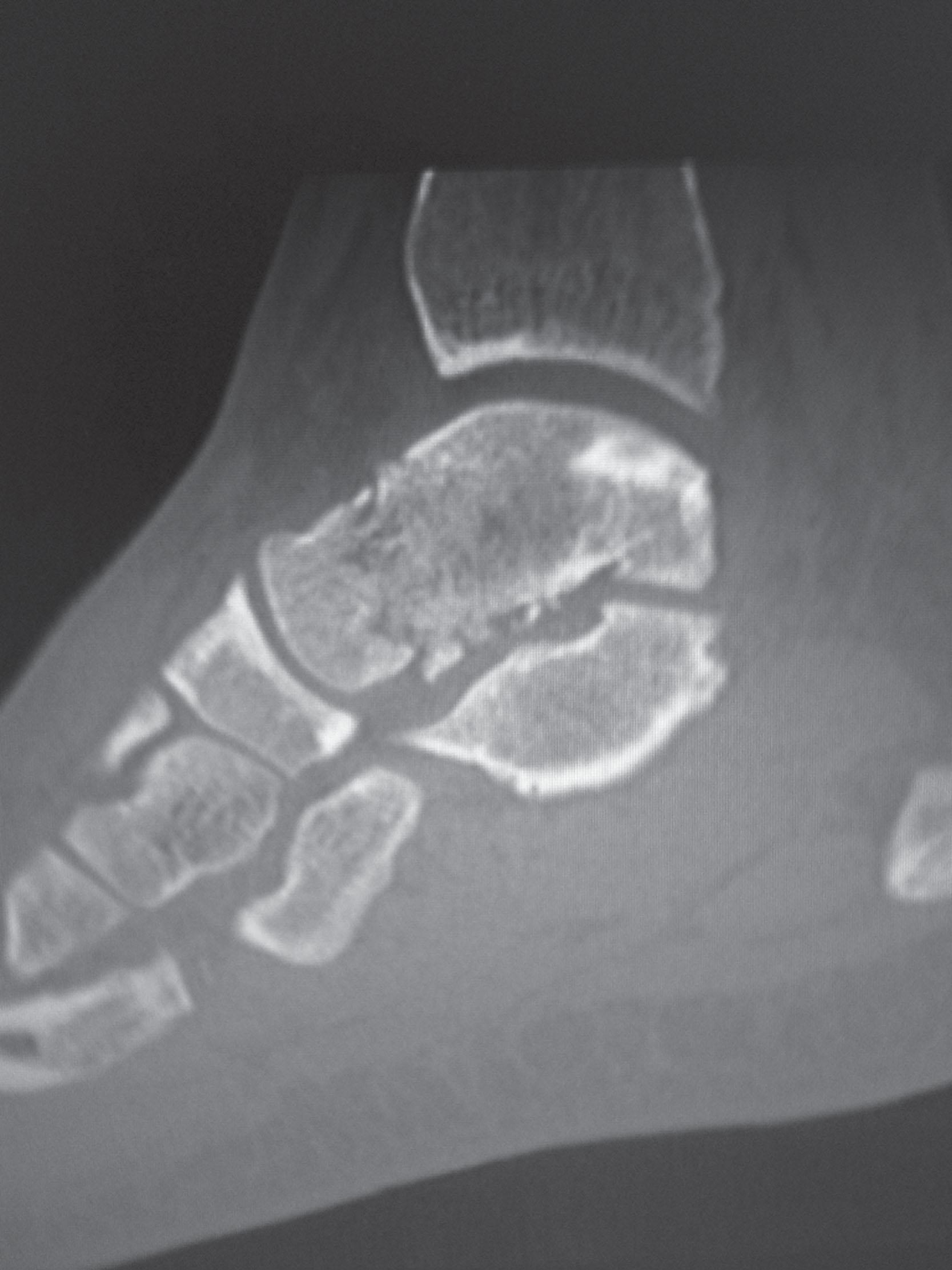
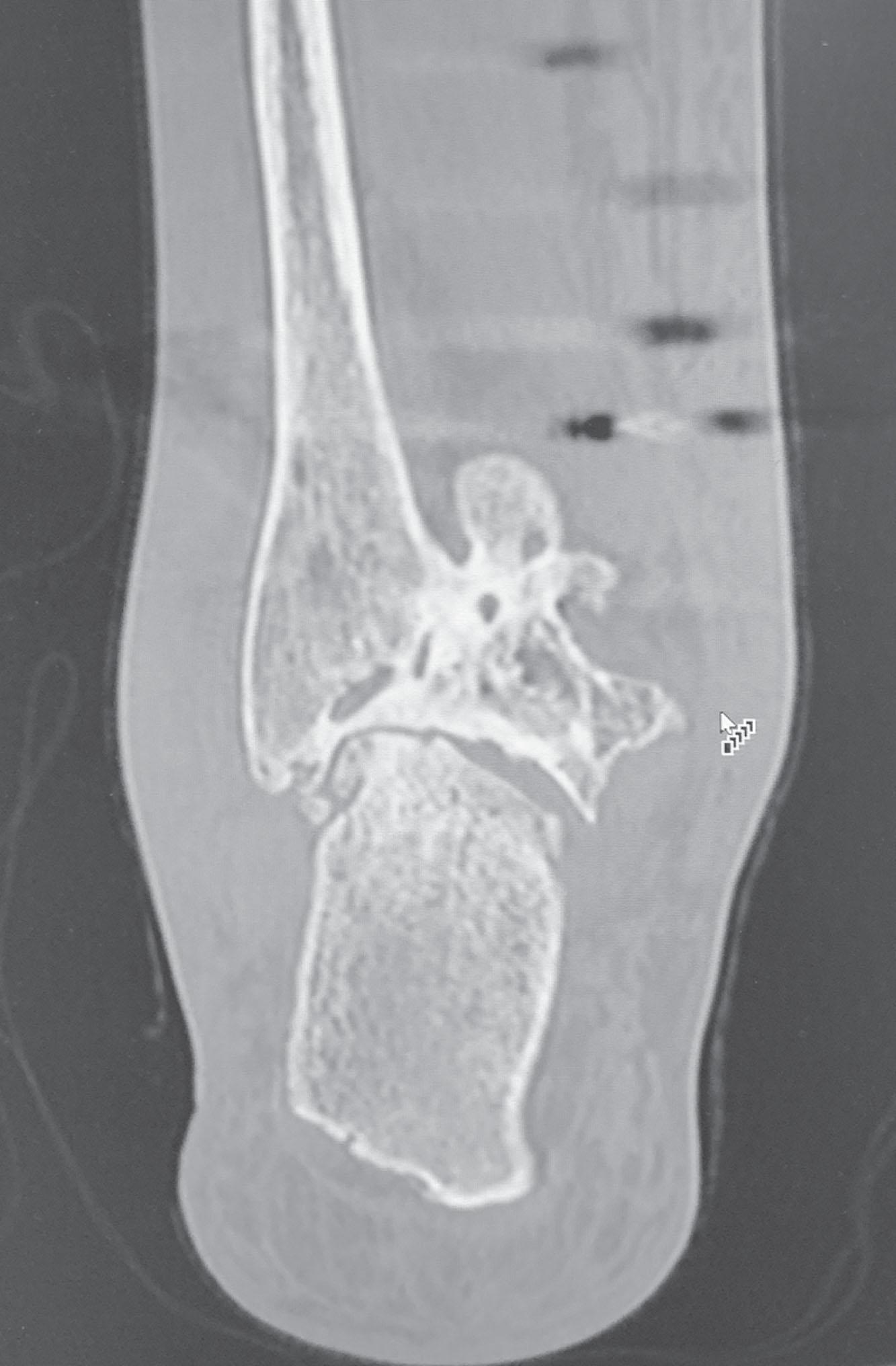
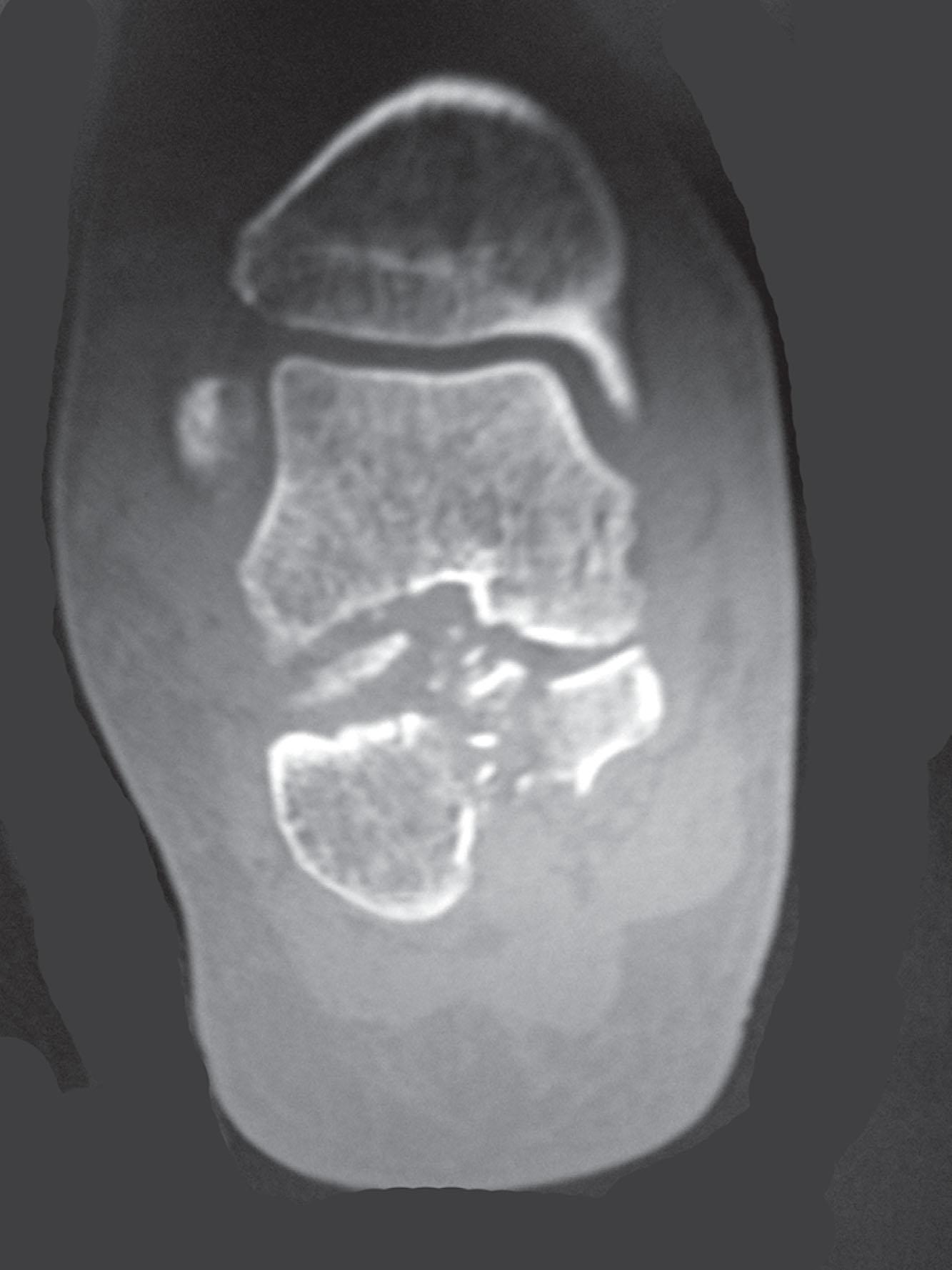
Arthrodesis is the primary surgical treatment for arthritis of the hindfoot.
The etiology of arthritis affects the outcomes after subtalar arthrodesis. Subtalar arthrodesis in atraumatic setting has reported success rates of 80% to 90% good-to-excellent results. Curiously, when performed in the setting of posttraumatic arthritis, good-to-excellent results are reported in only 50% to 60% of cases despite high fusion rates. Flemister et al noted a fusion rate of 96% in a series of 86 subtalar arthrodeses resulting from complications after calcaneal fracture, yet patients only achieved a mean American Orthopaedic Foot and Ankle Society (AOFAS) Hindfoot score of 75/100. Primary arthrodesis after calcaneal fractures may be preferred when joint comminution suggests a high likelihood of developing posttraumatic arthritis.
One possible reason for poor results of subtalar fusion after comminuted calcaneal fractures include a loss of calcaneal height, loss of talar declination, and anterior ankle impingement. For these patients, many have advocated a structural autograft bone block subtalar arthrodesis to restore the calcaneal height, and talar declination. Garras et al reported on the use of frozen structural allograft for this purpose and noted a 90% successful fusion rate. Frigg et al reported on the use of porous tantalum interposition for ankle and subtalar arthrodesis and found that fusion was successful in nine of nine patients. The advantage appears to be rapid ingrowth into the tantalum without donor-site morbidity.
The approach for subtalar fusion may be altered in cases of severe deformity. Saville et al reported using the medial approach for hindfoot arthrodesis when severe valgus deformity is present. All wounds healed, and 17 of 18 patients went on to successful fusion over 5.6 months. The authors suggested that when the hindfoot is in extreme valgus, use of a medial approach may help avoid tension-related lateral wound problems and decrease sural nerve complications. However, talar dome avascular necrosis has been described after a medial approach to the hindfoot, and this approach should be used with caution.
Minimally invasive approaches have also been described, including an arthroscopic subtalar arthrodesis using a posterolateral portal (just lateral to the Achilles tendon) and an anterolateral portal (centered upon the sinus tarsi) as well as a posterior arthroscopic approach using two posterior portals (medial and lateral to the Achilles tendon). The main advantage of an arthroscopic approach is decreased wound issues. However, fusion rates and other parameters have not been shown to be superior to traditional approaches. Scranton et al reported on a comparison of open versus arthroscopic subtalar arthrodesis and noted that there was minimal difference in operative time: 58 minutes for the open procedure versus 63 minutes for the arthroscopic procedure. Similarly, Rungprai and colleagues compared outcomes between open and posterior arthroscopic subtalar arthrodeses in 121 patients and noted that the union rates and complication rates are similar between the two groups. Time to union and return to work, however, were shorter for the arthroscopic arthrodesis group, though these may be biased by the surgeon’s knowledge of the surgical technique.
Regardless of approach, hindfoot positioning during subtalar arthrodesis can be challenging. Optimally, the calcaneus should be in slight valgus (approximately 5 degrees) relative to the talus. While weight-bearing hindfoot alignment views may be ideal to judge alignment, this is impractical in an operative setting. Thus, visual inspection and fluoroscopic imaging are most commonly used to determine hindfoot position during surgery. A line drawn directly on the patient’s skin from the posterior center of the knee to the center of the posterior ankle with the foot held so that the plane of the metatarsal heads is perpendicular to the long axis of the tibia can aid with intraoperative visual alignment.
Graft use (autograft, allograft, or bone substitute) and hardware configuration are additional options the surgeon must consider for hindfoot arthrodesis. The authors routinely use iliac crest autograft and cannulated lag screw fixation to achieve compression across the joint ( Fig. 21-10 ).
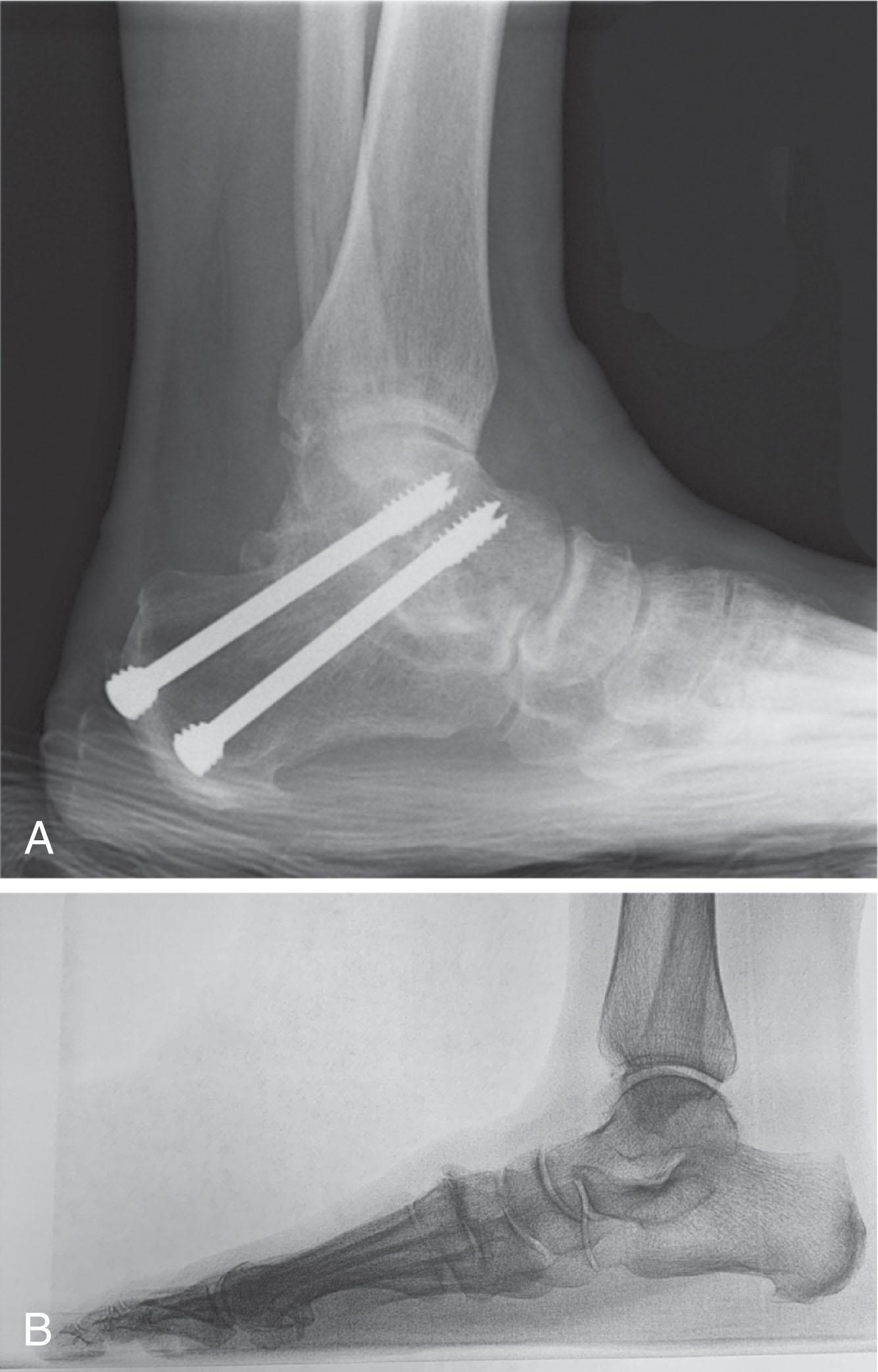
Radiographic parameters to differentiate fusion from nonunion are unclear. A good clinical outcome correlates with bone growth measured by CT scanning across the arthrodesis site of 25% to 49%.
The incidence of calcaneocuboid joint arthritis after calcaneal fracture has been reported to be between 33% and 76%, with a higher percentage in joint depression-type fractures. However, those with fractures involving the actual calcaneocuboid joint are typically asymptomatic. Astion and Wulker both noted that an isolated calcaneocuboid fusion has little effect on the motion of the adjacent joints and that the motion of the calcaneocuboid is small.
Isolated arthritis of the talonavicular joint (either resulting from trauma or degeneration) may benefit from isolated fusion. Indications for talonavicular arthrodesis include isolated arthritis ( Fig. 21-11 ), rheumatoid arthritis, or pes planovalgus deformity. However, arthrodesis of the talonavicular joint has a higher nonunion rate than other hindfoot fusions. This is due to the spheric shape of the joint and the resultant difficulty in exposure and preparation of the joint surfaces as well as the limited bone available for fixation. Published reports demonstrate a union rate between 63% and 97%. Chen et al reported a 94% union rate using either staples or screws without bone graft for isolated talonavicular joint fusions. Jarrell et al compared three methods of fixation and determined that there was no significant difference in load to failure between the three constructs.

Astion reported that isolated talonavicular joint fusion limits the subtalar joint to 8% of its native motion. In addition, fusing the talonavicular joint alone behaves similarly to the double hindfoot arthrodesis.
The traditional double arthrodesis (fusion of the talonavicular and calcaneocuboid joints) may be undertaken when these joints are diseased, while the subtalar joint is spared. Locking of the transverse tarsal joints results in an essentially immobile subtalar joint, and the double arthrodesis functions much like a triple hindfoot arthrodesis. Beischer et al noted that with a double or triple joint hindfoot fusion, the ankle joint range of motion during stance decreases by 33% while the ipsilateral knee range of motion increases by 13%.
Citing less than desirable results after triple arthrodesis, Sammarco et al recommended a modified double arthrodesis of the subtalar and talonavicular joints. They noted that all of their patients were satisfied with the result, and only 1 of 16 patients required revision surgery for nonunion. Advantages of this type of double versus triple arthrodesis include reduced operative time and avoidance of potential calcaneocuboid nonunion (reported as 20% with the triple arthrodesis).
The triple arthrodesis is regarded by many as a salvage procedure. Typical indications include posttraumatic hindfoot arthritis, rheumatoid arthritis, or advanced progressive collapsing foot deformity. It is a demanding procedure. The goal is to restore plantigrade position of the foot, with the hindfoot in slight valgus. Not infrequently, a forefoot osteotomy is required to correct forefoot rotation in the coronal plane.
Potential complications of triple arthrodesis may degrade outcomes. Malunion is not uncommon and frequently leads to dissatisfaction for both the surgeon and patient. Resnick et al demonstrated that placing the calcaneus in too much valgus ( Fig. 21-12 ) increases the force on the deltoid ligament by 76% during weight bearing. In contrast, a varus hindfoot places pressure on the lateral column and fifth metatarsal and may lead to lateral ankle instability and ankle arthritis. Arthritis in adjacent joints (ankle and tarsometatarsal joints) has been reported after triple arthrodesis in up to 58% of patients in a 21-year follow-up. Nonunion and avascular necrosis have been reported. Graves and Beischer noted that 28% to 33% of their patients walked with a limp after triple arthrodesis despite successful fusion.
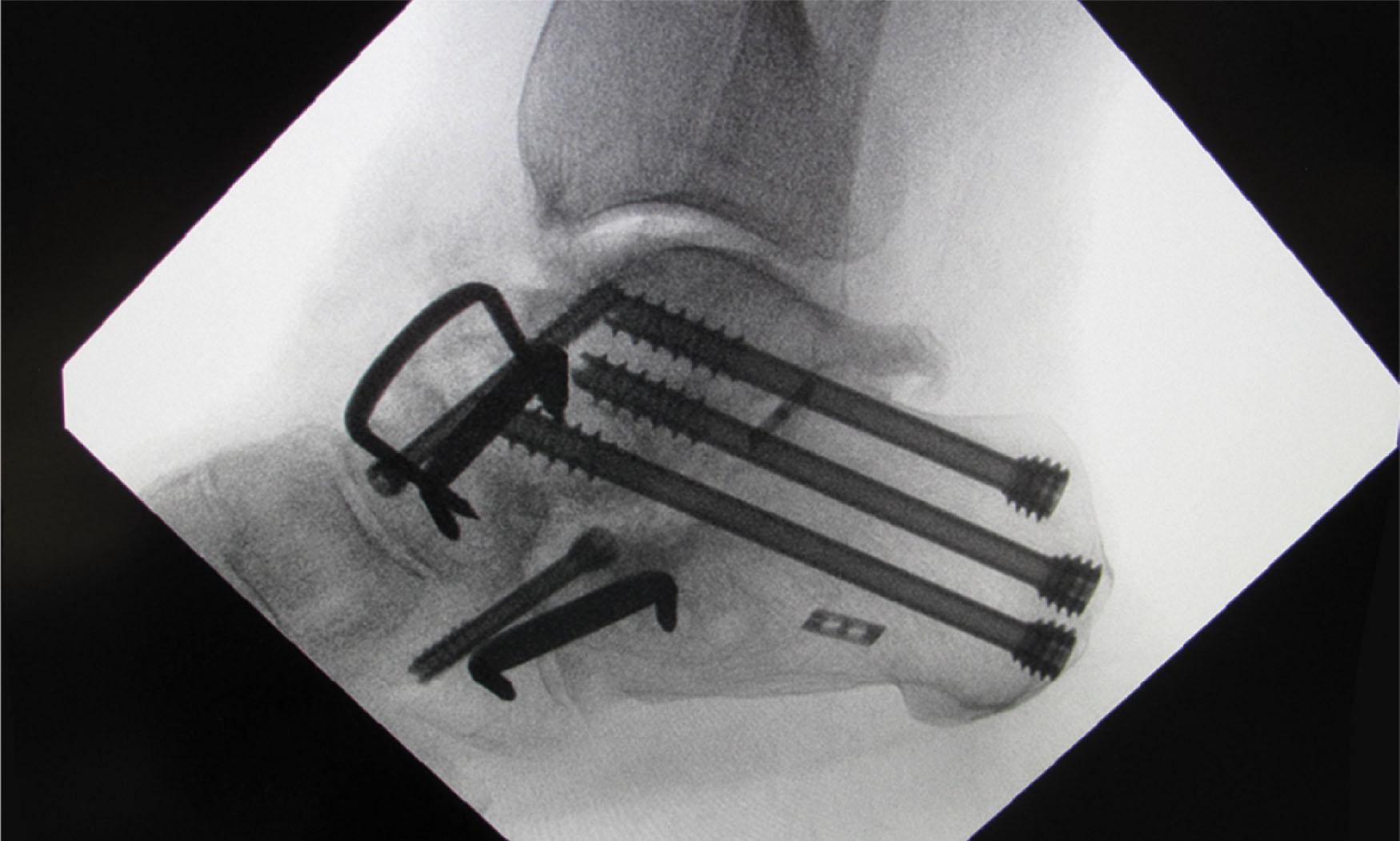
For those with disabling hindfoot and ankle arthrosis, Acosta et al recommended pantalar arthrodesis involving the tibiotalar, subtalar, talonavicular, and calcaneocuboid joints ( Fig. 21-13 ). Although 23 of 27 patients went on to solid fusion, there was a 37% complication rate, and only five patients had an excellent result. The authors suggested that, like the triple arthrodesis, this procedure be considered only as a salvage operation.
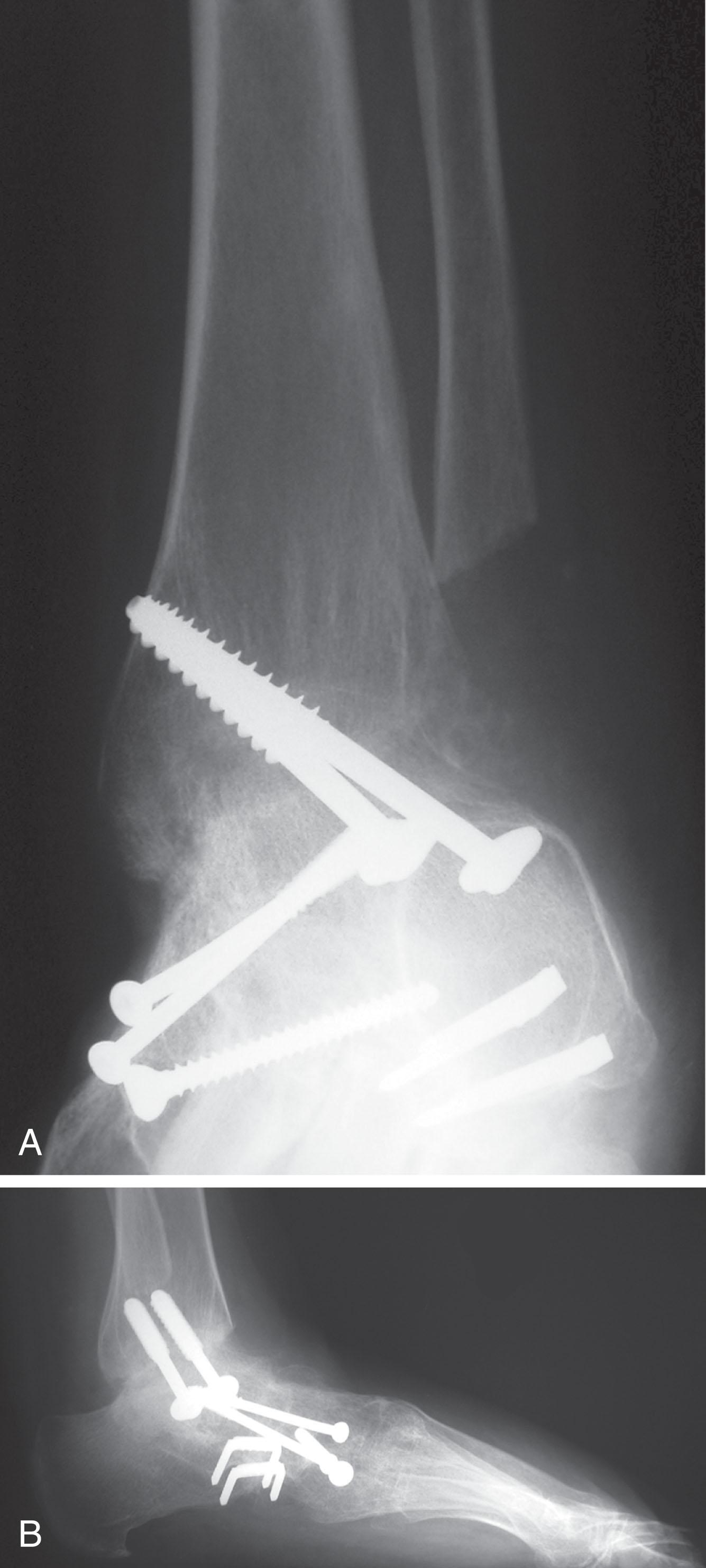
Midfoot arthritis frequently develops as a sequela of a fracture or dislocation through the Lisfranc joint but may also develop spontaneously because of osteoarthritis or inflammatory arthritis. Thus it generally has a bimodal presentation: those with a traumatic etiology often seek care in their thirties, while those with a nontraumatic etiology often present in their fifties. Davitt et al hypothesized that midfoot degeneration is the result of metatarsal length differences, particularly a longer second metatarsal. Wearing high-heeled shoes may also contribute to midfoot arthritis. Arthritis in any of the tarsometatarsal joints in the absence of a history of trauma may represent an early Charcot (joint) deformity. Charcot arthropathy can develop with diabetes as well as with peripheral neuropathy and other neurologic disorders ( Fig. 21-14 ).
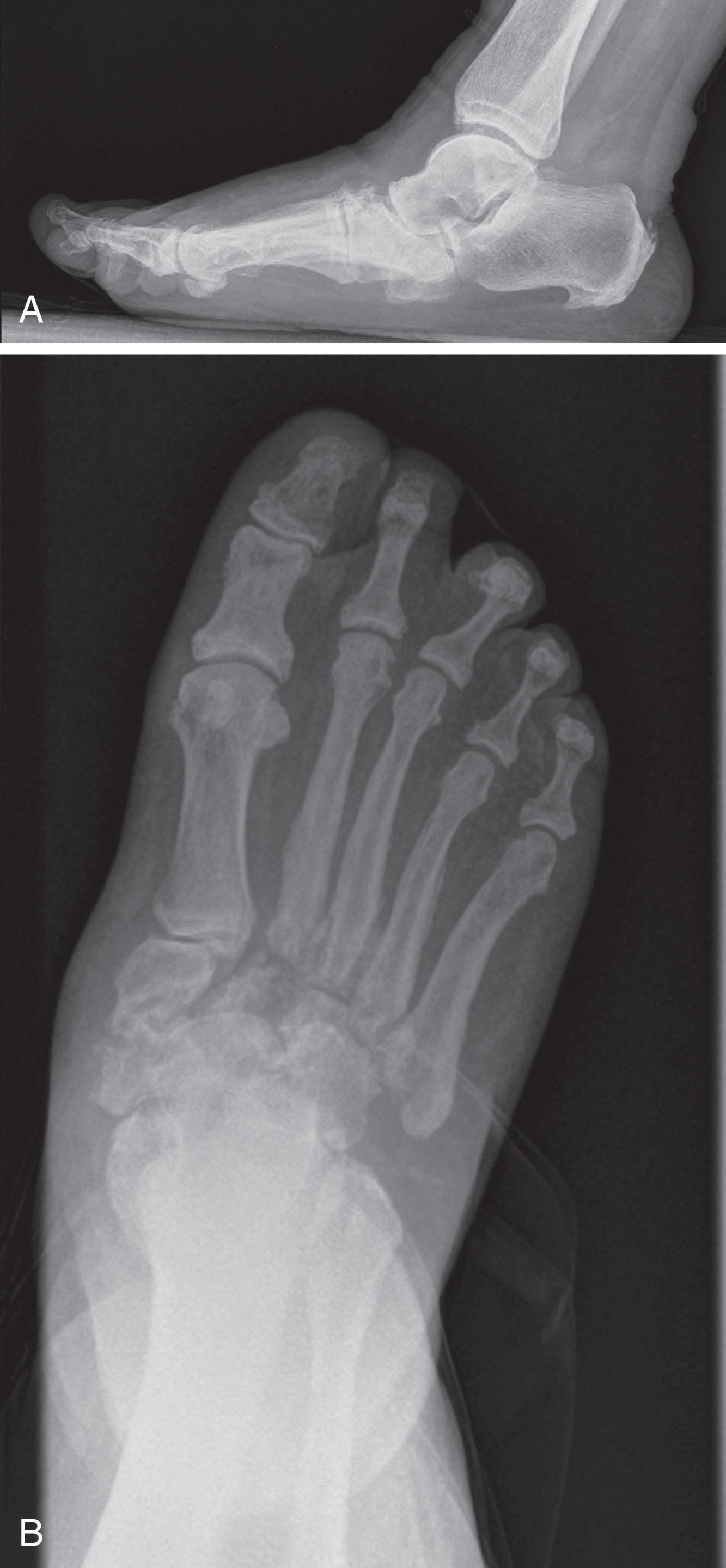
Regardless of the cause, the development of midfoot arthritis can be an extremely disabling condition because of the stress placed on the longitudinal arch with weight bearing. A bony prominence may develop on the dorsal aspect of the midfoot because of osteophyte formation, which makes wearing shoes painful. A progressive flatfoot deformity can also develop from instability of the metatarsocuneiform (MTC) or tarsometatarsal joints, with development of a plantar bony prominence and subsequent callus formation ( Fig. 21-15 ). Jung et al noted four presentations associated with tarsometatarsal joint arthritis: no deformity, pes planovalgus, hallux valgus, and the rocker-bottom deformity. Mann et al noted that 78% of patients with midfoot arthritis had abnormal foot posture and difficulty with shoe wear.
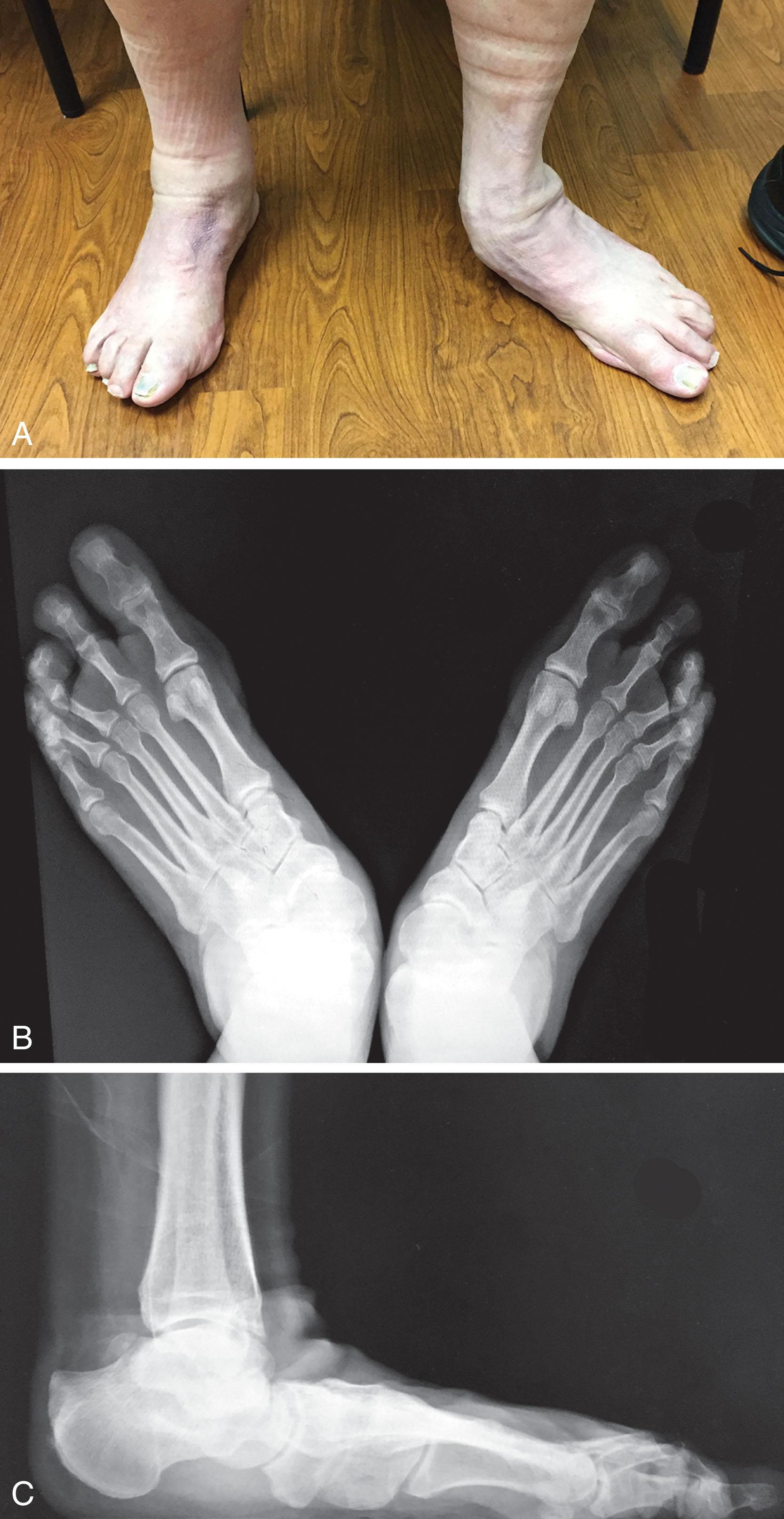
A careful preoperative physical examination is necessary to determine the extent of the midfoot and hindfoot malalignment. In examination of the foot, passive manipulation of the midfoot involves abduction of the forefoot and a pronation stress test to determine the location of maximal pain. The piano-key test ( Fig. 21-16 ) is positive when a plantarly directed force applied to the metatarsal head elicits pain in the same tarsometatarsal joint. This is a sensitive indicator of a symptomatic joint or joints.
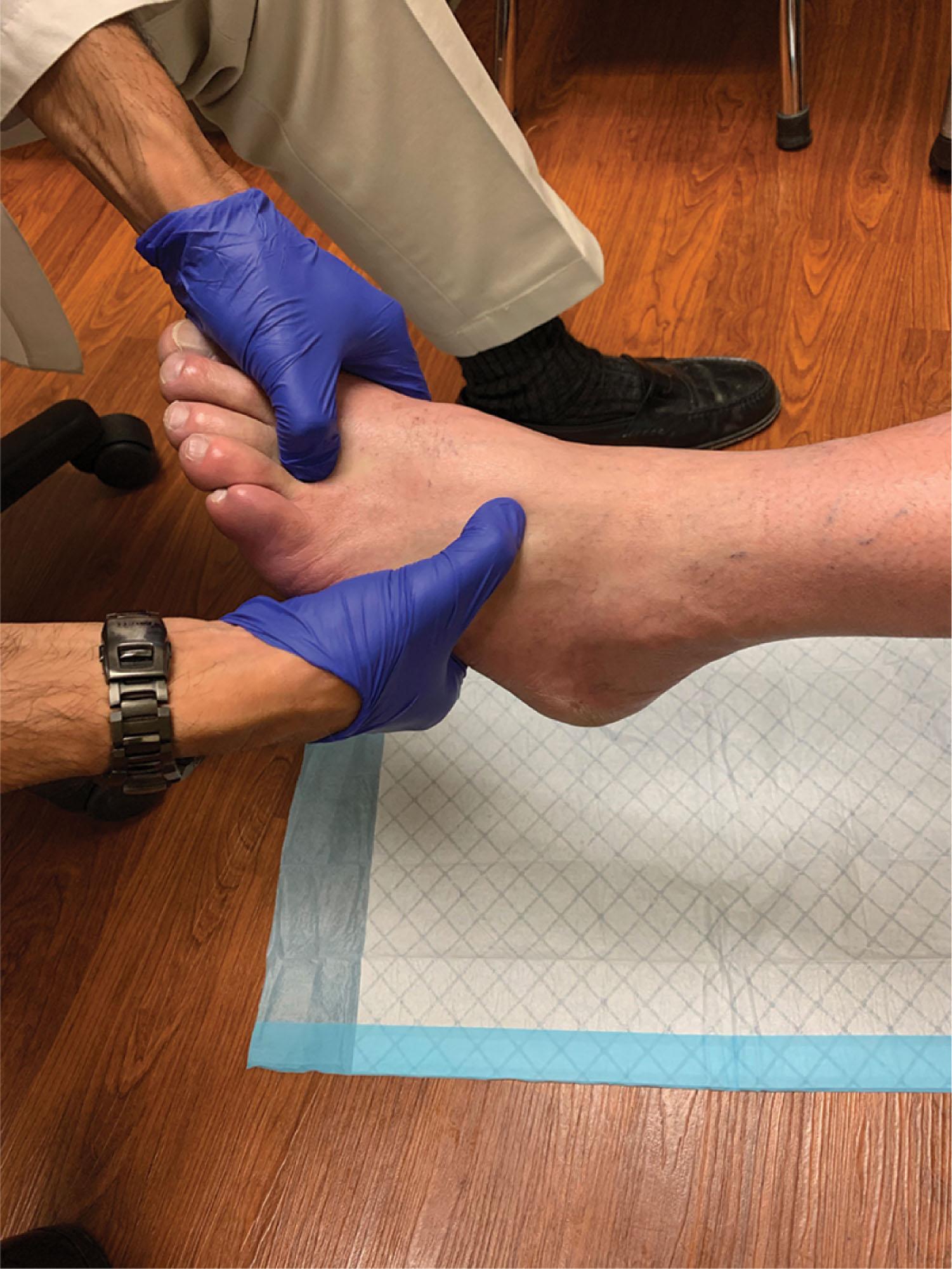
Malalignment at the transverse tarsal joint and a valgus deformity of the hindfoot often are associated with severe midfoot arthritis. Correctable or supple hindfoot valgus associated with medial column arthritis should reduce with proper restoration of alignment (reduction of any varus or rotational deformity, abduction, and dorsiflexion) during the midfoot arthrodesis. Any fixed or residual valgus deformity without arthritis should be addressed with a medial displacement osteotomy, creation of plantarflexion through the first ray, or lateral column lengthening ( Fig. 21-17 ). Moreover, gastrocnemius recession or Achilles lengthening may be necessary after correction is achieved and bone alignment is restored to obtain a plantigrade foot.

Radiographically, the medial column is reduced when the medial border of the first metatarsal is aligned with the medial border of the medial cuneiform. The middle column is aligned when the medial border of the second metatarsal is aligned with the medial border of the intermediate cuneiform. For the lateral column, reduction is achieved when the medial border of the fourth metatarsal is aligned with the medial border of the cuboid. On the lateral radiograph, restoration of the first metatarsal declination angle and arch height are imperative.
Arthritic changes such as joint space narrowing can be seen on the weight-bearing anterior posterior radiograph. On the lateral radiograph, midfoot collapse of the tarsometatarsal joints may or may not be seen. Jung et al noted that with primary osteoarthritis of the tarsometatarsal joints radiographs demonstrate a lower medial cuneiform height than that of posttraumatic arthritis. Menz et al reported that foot structure differs in elderly patients with midfoot arthritis compared with those without. In those with radiographic evidence of naviculocuneiform and talonavicular joint arthritis, they noted significantly flatter feet as evidenced by a small calcaneal inclination and a larger calcaneal first-metatarsal angle.
Conservative management of midfoot degenerative arthritis includes a soft or rigid custom-molded orthosis or full-length carbon fiber insert that provides support to the longitudinal arch. Rao et al demonstrated that these orthotics significantly lessen the load duration and the intensity borne by the midfoot. Ibuki et al also reported that carbon fiber foot plates provided equivalent improvements in pain, activity levels, and walking ability when compared with custom-molded semirigid orthotics. A polypropylene AFO may be used for more advanced degenerative arthrosis. Cast immobilization and, occasionally, a short-leg brace may be used to diminish pain. Unfortunately, as arthritis of the MTC joint progresses, with subsequent loss of the longitudinal arch and abduction of the forefoot, the use of AFOs becomes more limited. An AFO does not reorient the foot but does add support and stability to the foot. Corticosteroid injections administered into the midfoot joints may be effective for up to 4 months, especially with patients with a BMI of less than 30.
In time and with progression of deformity, surgical intervention is indicated. Surgery consists of an arthrodesis of the involved midfoot joints. Most often, the second and third tarsometatarsal joints are involved. The first metatarsal medial cuneiform articulation is involved less often and the fourth and fifth metatarsocuboid articulation least often. Whether to include the intercuneiform articulations depends on inspection of these areas for arthrosis. Sangeorzan et al infrequently incorporated the intercuneiform joints (1 of 16), whereas Mann et al and Horton and Olney incorporated them in the arthrodesis technique more often. If any doubt exists, Mann et al suggest incorporating the intercuneiform joint within the arthrodesis.
In the patient with a pes planus deformity and abduction of the forefoot, it is important to reestablish the normal alignment of the midfoot at surgery. This is accomplished by bringing the medial Lisfranc joint into normal alignment with the hindfoot by adducting and plantar flexing the first, second, and third MTC articulations.
Promising results have been obtained with interposition arthroplasty for lateral column arthritis, and this procedure may be used as a second-stage procedure if needed for continued symptoms. Berlet et al performed tendon interposition for fourth and fifth tarsometatarsal arthritis and noted that six of eight patients were satisfied. Shawen et al used ceramic sphere interposition. Their patients showed an 87% improvement in AOFAS scores and 11 of 11 would undergo the procedure again.
Although a lateral column arthrodesis is much more difficult to achieve, on occasion it may be necessary to realign the entire Lisfranc joint in the presence of severe deformity. Komenda et al and Sangeorzan et al recommend that the lateral column not be included in the arthrodesis because this area is usually asymptomatic even with significant radiographic evidence of arthrosis. They did use temporary internal fixation when the lateral column was realigned but did not routinely perform arthrodesis for the lateral column. The potential concern with lateral midfoot arthrodesis as part of a medial column or central column procedure is that it creates an extremely rigid midfoot. Lin et al reported that fusion of the fourth and fifth TMT joints was associated with significantly poorer functional and subjective scores in 16 patients. In neuropathic conditions, it may be necessary to achieve the additional stability afforded by inclusion of the lateral column joints, but in posttraumatic or inflammatory cases, the authors prefer to avoid arthrodesis of the lateral column.
Multiple fixation methods have been described, including an in situ bone dowel technique, slot graft technique, plate and screw fixation, as well as Kirschner (K)-wire fixation with bone grafting. A plantarly placed plate and screws may offer a mechanical advantage over screws alone ( Fig. 21-18 ); however, a comparison of a dorsomedial locking plate with crossed screws to secure the first MTC joint showed no significant difference in mechanical strength. The authors believe that realignment with compression screw fixation with dorsal compression plating across the respective TMT joints and a medial column plate as a neutralization or primary construct is needed to obtain a successful result in most cases. Midfoot and hindfoot arthrodesis with Nitinol compression plates can yield a 95% union rate and appears to be a promising technique to achieve fusion ( Fig. 21-19 ).
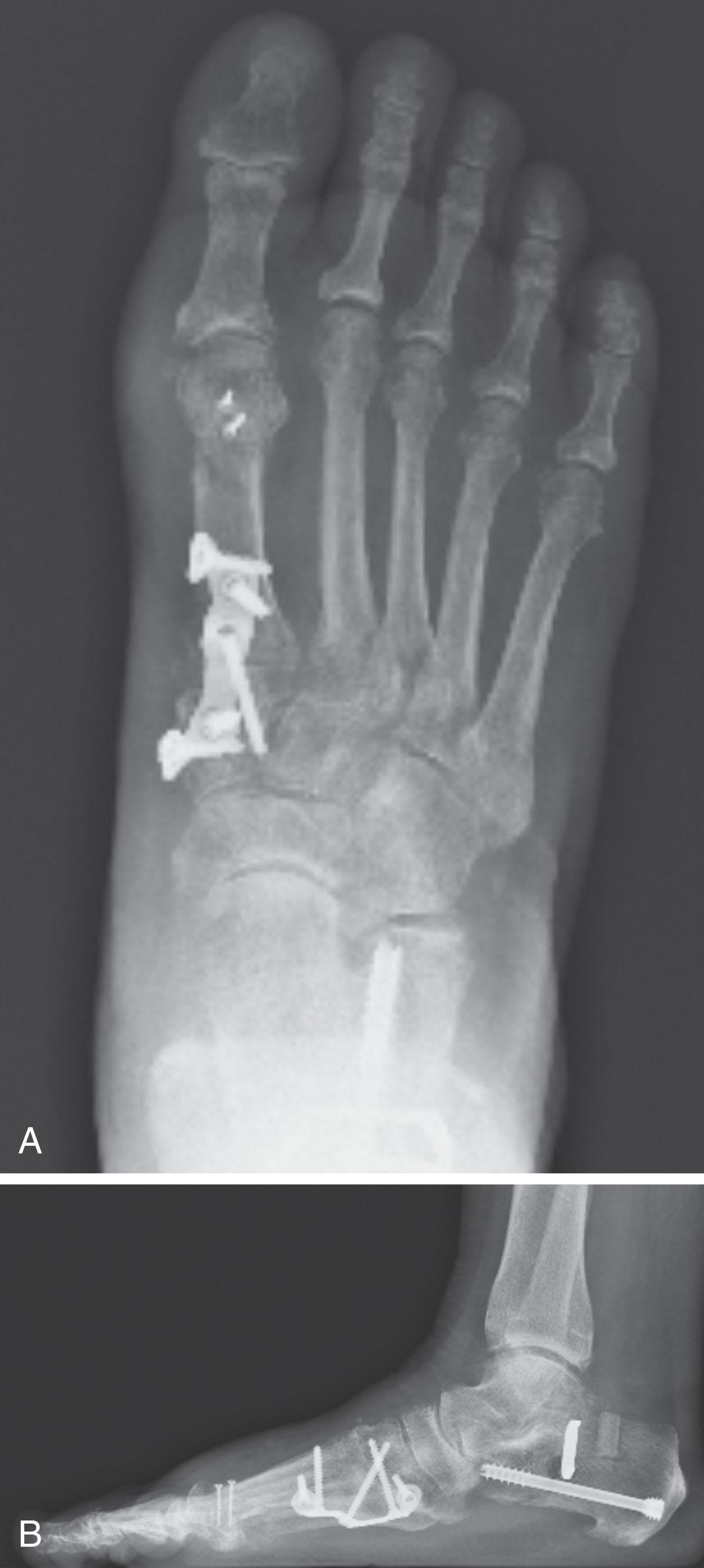
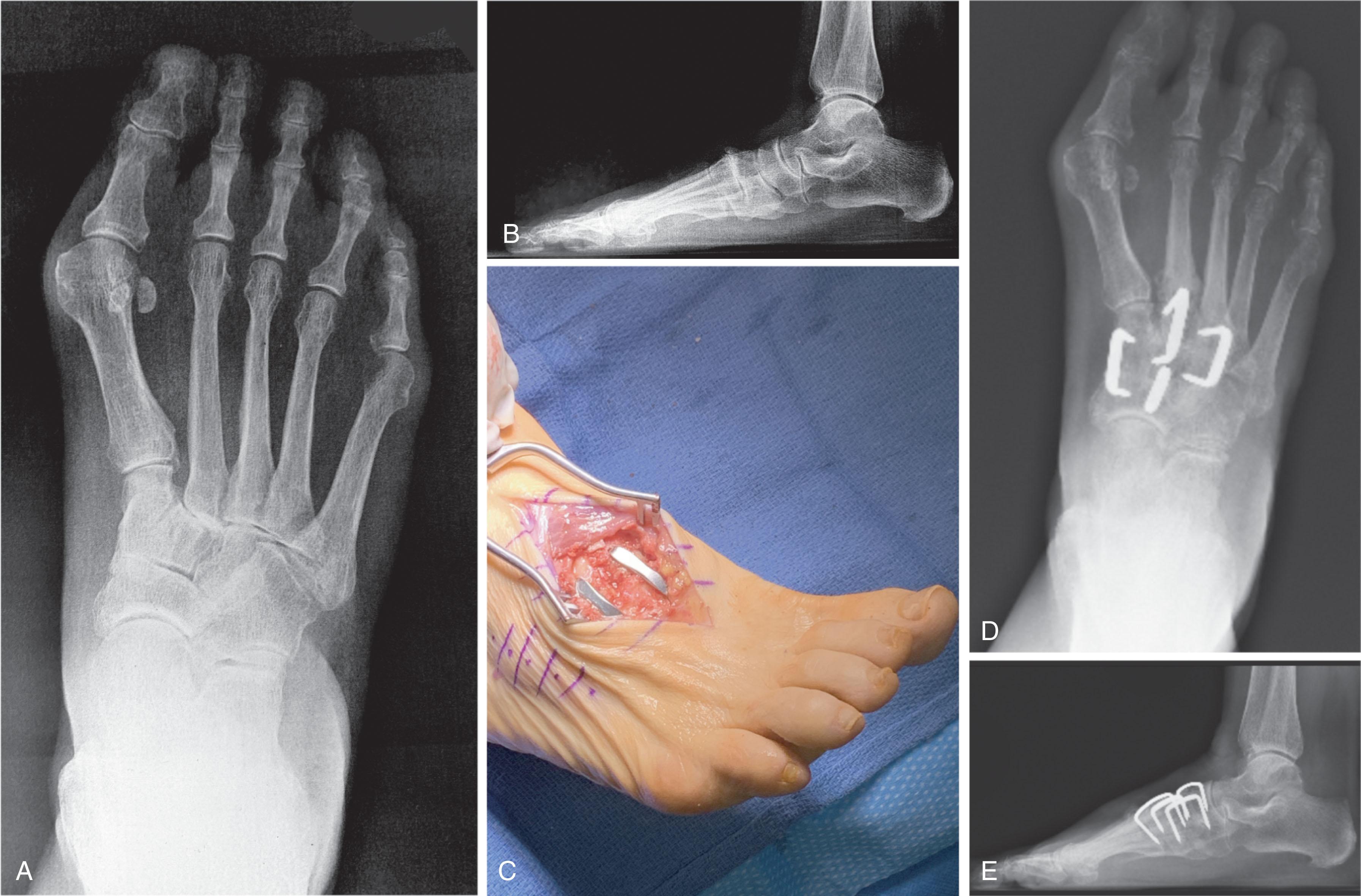
Whether to perform reduction of a midfoot deformity has been a controversial topic. Johnson and Johnson reported on in situ fusions for patients with mild and moderate midfoot deformities, finding 9 of 13 patients (70%) reported good or excellent results. Sangeorzan et al advocated reduction of the pes planus and abduction deformity and noted 11 of 16 cases with satisfactory results (69%). Horton and Olney performed three in situ fusions and six realignment arthrodeses on eight patients (nine feet) for posttraumatic or degenerative arthrosis of Lisfranc joints, noting a strong correlation between reduction of the deformity and the outcome. Mann et al, while reporting that 38 of 41 patients with primary, traumatic, or inflammatory arthrosis of the midfoot were satisfied, advocated for reduction of the deformity. Komenda et al stated that if there is 15 degrees of malalignment in the transverse or sagittal plane or greater than 2 mm of displacement, reduction of the deformity is indicated.
The use of an autogenous iliac crest graft may increase the success rate of arthrodesis. Komenda et al used an ancillary graft in one third of cases and Mann et al in one fourth of cases. Sangeorzan et al stated that an additional graft was not necessary. The current authors prefer to use iliac crest when structural defects require its use. However, the use of bone healing and enhancing substrates, such as platelet concentration systems, have shown promise. Han and colleagues demonstrated that platelet-rich plasma (PRP) enhances osteoinductivity. Landi et al noted an increase in fusion rates at 3 months as well as an increase in bone density by using a platelet gel in lumbar fusions. Hauschild reported on a successful fusion in a canine tarsal joint by using PRP. Gandhi et al reported on nine patients with foot and ankle nonunions. Using PRP and autologous bone graft at time of revision, the mean time to fusion was 2 months. Bibbo and colleagues also used PRP for foot and ankle fusions, concluding that PRP increased the fusion rate with low complications.
Electrical, magnetic, or ultrasonographic bone stimulation can also be helpful. Several studies have reported on the positive influence of each of these modalities. Dhawan reported a faster time to fusion with the use of pulsed electromagnetic field (PEMF) therapy in hindfoot fusions.
There is no consensus on the preferred approach for all midfoot arthritic problems, and the technique used must be tailored to the individual patient's problem and the surgeon's experience. The authors' preferred approach is to incorporate the medial column joints and to leave the lateral column mobile; in general, a two-incision technique is used for the arthrodesis, with a medial and dorsal incision spaced as far apart as possible to minimize wound-healing problems.
Patient satisfaction after midfoot fusion ranges from very good to acceptable. Nemec and colleagues noted 90% patient satisfaction. Mann et al reported an overall satisfaction of 86%, and Jung et al reported an 87% satisfaction. However, Patel et al suggested that patients may only experience 60% reduction in pain.
The magnitude of surgery requires a lengthy postoperative convalescence. After midfoot arthrodesis, most workers have difficulty returning to an occupation that requires standing for a full 8-hour day. Postoperative complications include skin slough, metatarsalgia, and incisional neuromas.
Nonunion rates have been reported to be between 3% and 8%, but anecdotal evidence points to a higher rate. Moreover, in a review of complications associated with midfoot and hindfoot arthrodesis, Bibbo et al reported that wound problems can be expected in 3% to 5% of nondiabetic patients undergoing elective arthrodesis procedures, but that rate increased up to 53% in diabetic patients ( Fig. 21-20 ). Given the increasing numbers of diabetic patients in the United States and other countries, every effort should be made to prevent complications by evaluating and treating the vascular, neurologic, glycemic, and general nutritional status of the patient before arthrodesis. Hindfoot alignment must be corrected intraoperatively before midfoot arthrodesis, and concomitant osteotomies (see Fig. 21-17 ) or staged hindfoot reconstruction, or both, should be considered.
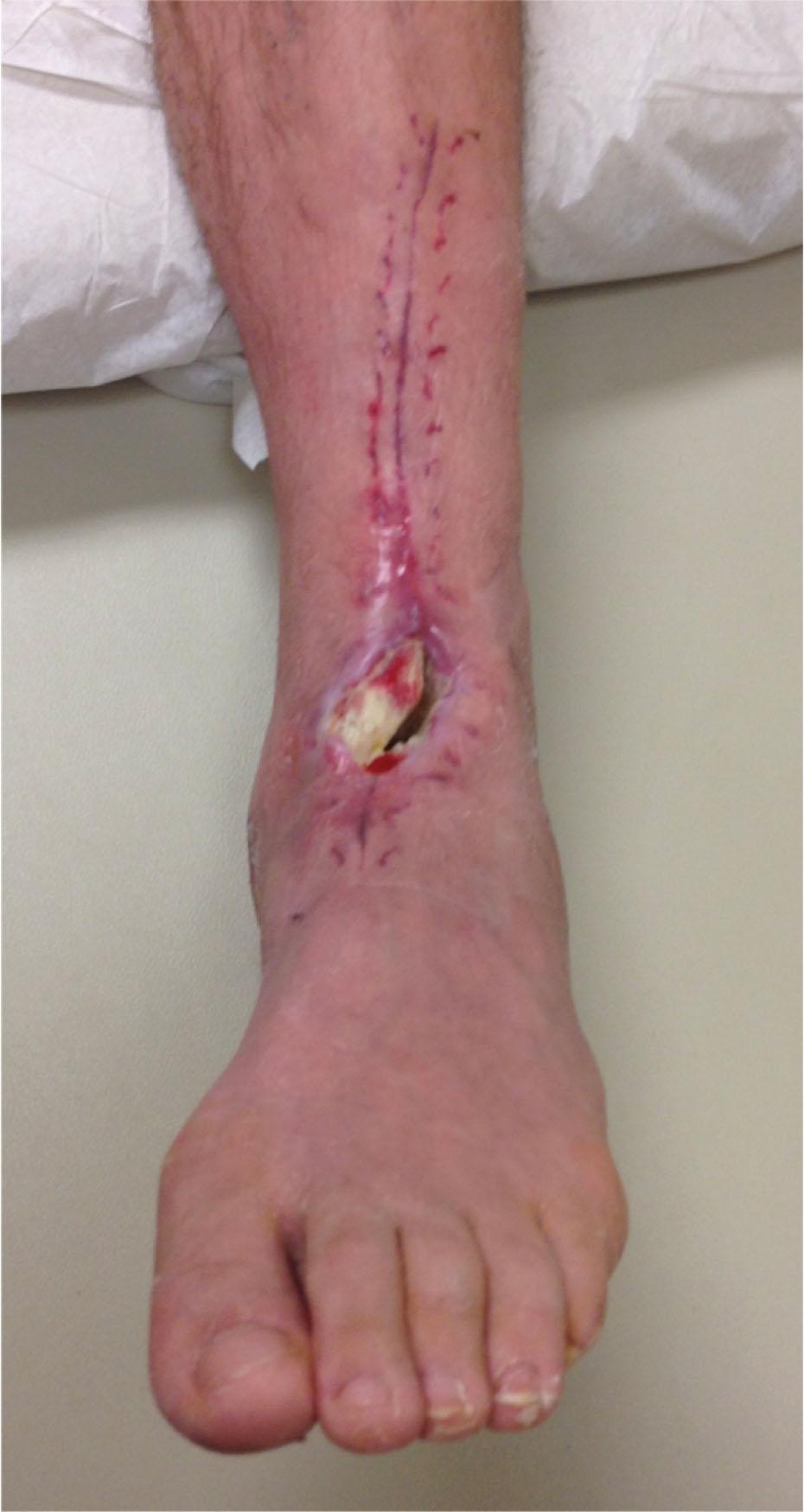
Rheumatoid arthritis (RA) is a systemic autoimmune disease characterized by synovitis, tenosynovitis, periarticular bone loss, and osteoporosis. It can affect both small and large joints, is generally symmetric, and affects both the upper and lower limbs. The disease affects 0.3% to 2.1% of the general population, and Rana has estimated that five million people in the United States suffer from rheumatoid arthritis. RA is two to four times more common in women than in men, yet no predilection exists for any single ethnic group. Onset can occur at any age, but the prevalence increases with age, peaking during the third to fifth decades. The disease course generally follows one of three pathways: (1) a relentless, destructive, and aggressive course; (2) a monocyclic course notable for a single episode of synovitis without permanent cartilage damage; and (3) a polycyclic course with multiple episodes of attack followed by remissions. Up to 70% of cases follow the polycyclic course.
The actual cause of the disease is unknown; however, genetic and environmental factors may play a role in etiology. Patients with an identical twin who has RA are four times more likely to develop RA than nontwin counterparts. Associations have also been found with viral infections, including cytomegalovirus, rubella, Epstein-Barr virus, and parvovirus. These viral agents may mimic portions of human leukocyte antigen (HLA) DR4, which stimulates the immune system to begin attacking the synovial lining of the joint in genetically susceptible individuals. Further etiologic studies are needed to fully elucidate the cause of RA.
The disease can affect all joints of the body but has a predilection for the small joints of the hand and foot. Much attention has been centered on rheumatoid deformities of the hand in terms of initial involvement of individual joints; with acute onset, however, the feet are involved slightly more often than the hand (15.7% vs. 14.7%) (Short et al cited by Calabro ). Foot and ankle symptoms account for more than 50% of the presenting complaints, and it has been reported that a higher body mass index positively correlates with poorer foot health in those diagnosed with RA. In addition, it has been estimated that 85% to 90% of patients with RA will eventually experience foot or ankle problems.
Moreover, persons affected with mild-to-moderate rheumatoid arthritis with concomitant foot involvement have marked reduction in mobility and functional capacity. An increased incidence of foot problems occurs with duration of the disease process, and in chronic RA, Michelson reported that ankle and hindfoot symptoms were much more common (42%) than forefoot symptoms (28%) in a series of 99 patients followed in an outpatient setting. In chronic rheumatoid arthritis, symmetric involvement is common. Early in the disease process, asymmetric involvement may be observed, but in chronic cases, symmetric disease is common.
Early complaints of patients with RA involve poorly defined forefoot pain and metatarsalgia. Typically, these complaints result from synovitis and an intraarticular effusion, which lead to painful ambulation. Poorly defined metatarsalgia can indicate an interdigital neuroma; in time, however, synovitis and deformity can make the diagnosis more straightforward. Zielaskowski has reported an association of rheumatoid synovitis, nodule formation, and interdigital neuroma.
A variable course of presentation occurs in the symptomatic rheumatoid foot. Nonspecific forefoot swelling is characterized by tenderness to palpation and pain on ambulation. The most common forefoot deformities are hallux valgus, subluxation or dislocation of the lesser MTP joints, and fixed hammer toe or claw toe deformities of the lesser toes ( Fig. 21-21 ).

Rheumatoid arthritis can be divided into the following four stages based on physical examination and radiographic findings. ( Table 21-1 )
| Stage | Physical Exam Findings | Radiographic Findings |
|---|---|---|
| Stage I | Discomfort and synovitis | No bone deformity or significant joint space narrowing |
| Stage II | Early involvement with flexible deformity | Minimal erosive changes |
| Stage III | Fixed soft tissue deformity | Significant erosive joint changes |
| Stage IV | Severe hallux valgus, dislocation of the lesser MTP joints with fixed hammer toe or claw toe deformities, pes planovalgus (flatfoot), and hindfoot arthroses | Articular destruction on radiographs |
In the early stages of rheumatoid arthritis, specific changes in the foot include inflammation of the synovium, with distention of the MTP joint capsule. Synovial proliferation leads to chronic capsule distention, resulting in loss of integrity of both the MTP joint supporting capsular structures and the collateral ligaments. With continued ambulation in the presence of soft tissue instability and with constant dorsiflexion stress on the MTP joints, subluxation and eventual dislocation occur. The most common pattern of joint erosion is on the plantar surface of the metatarsal head, supporting the notion that mechanical forces in conjunction with immune-mediated joint destruction are both at play. As the MTP joints of the lesser toes dislocate, the base of the proximal phalanx eventually comes to rest on the dorsal metatarsal metaphysis ( Fig. 21-22 ).
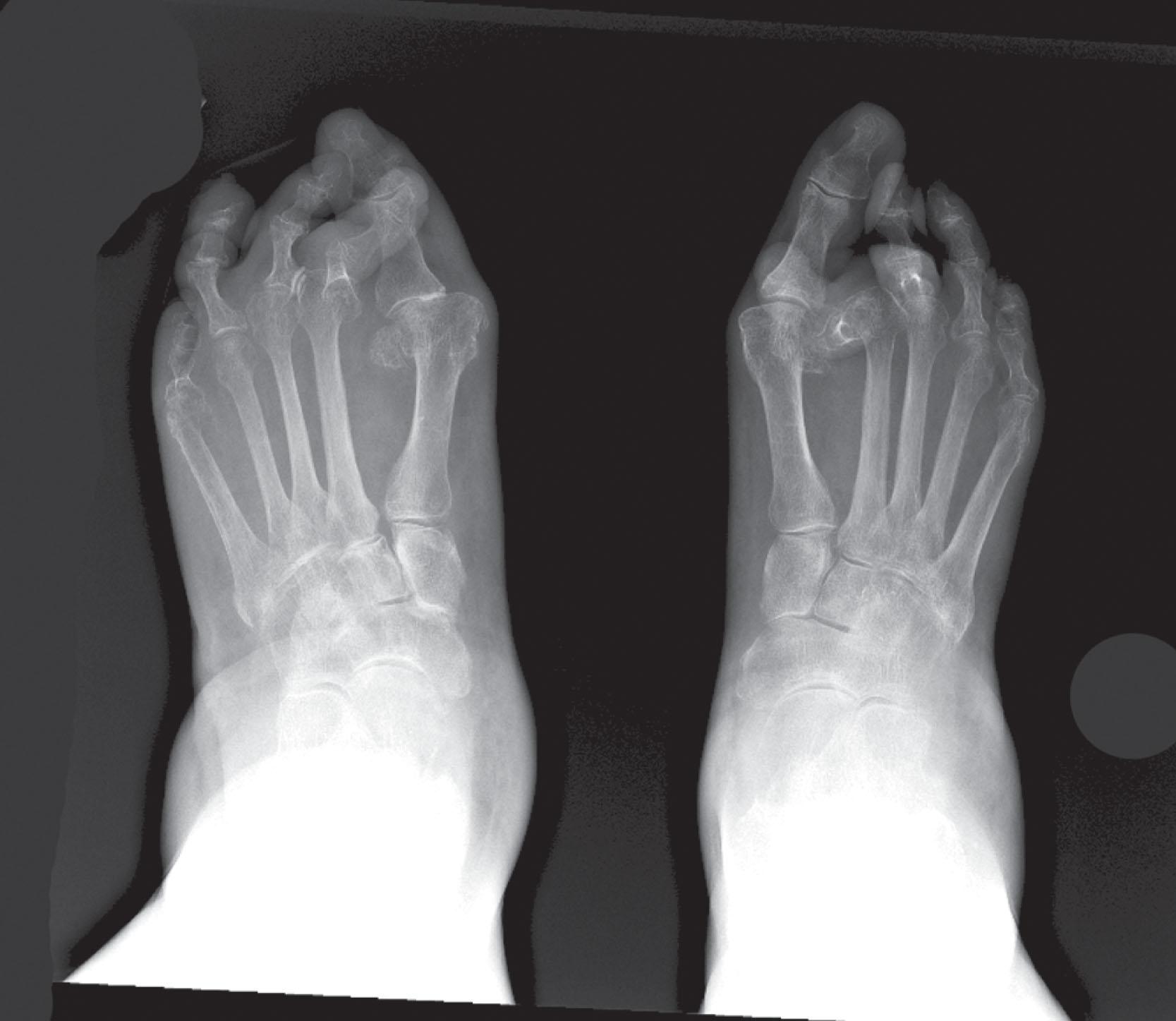
Progressive contracture of the long flexor tendons and the plantar intrinsic muscles lock the base of the proximal phalanx on the dorsal metatarsal neck. The proximal phalanx becomes fixed in a dorsiflexed position, creating a plantar-directed force on the metatarsal head. Simultaneously, the plantar fat pad is drawn distally, leaving only an extremely thin soft tissue covering on the plantar aspect of the metatarsal heads ( Fig. 21-23 ). The loss of the protective plantar fat pad cushion, coupled with increased stress on the underlying skin, can lead to the development of intractable plantar keratotic (IPK) lesions and, in time, ulceration of the plantar skin ( Fig. 21-24 ).
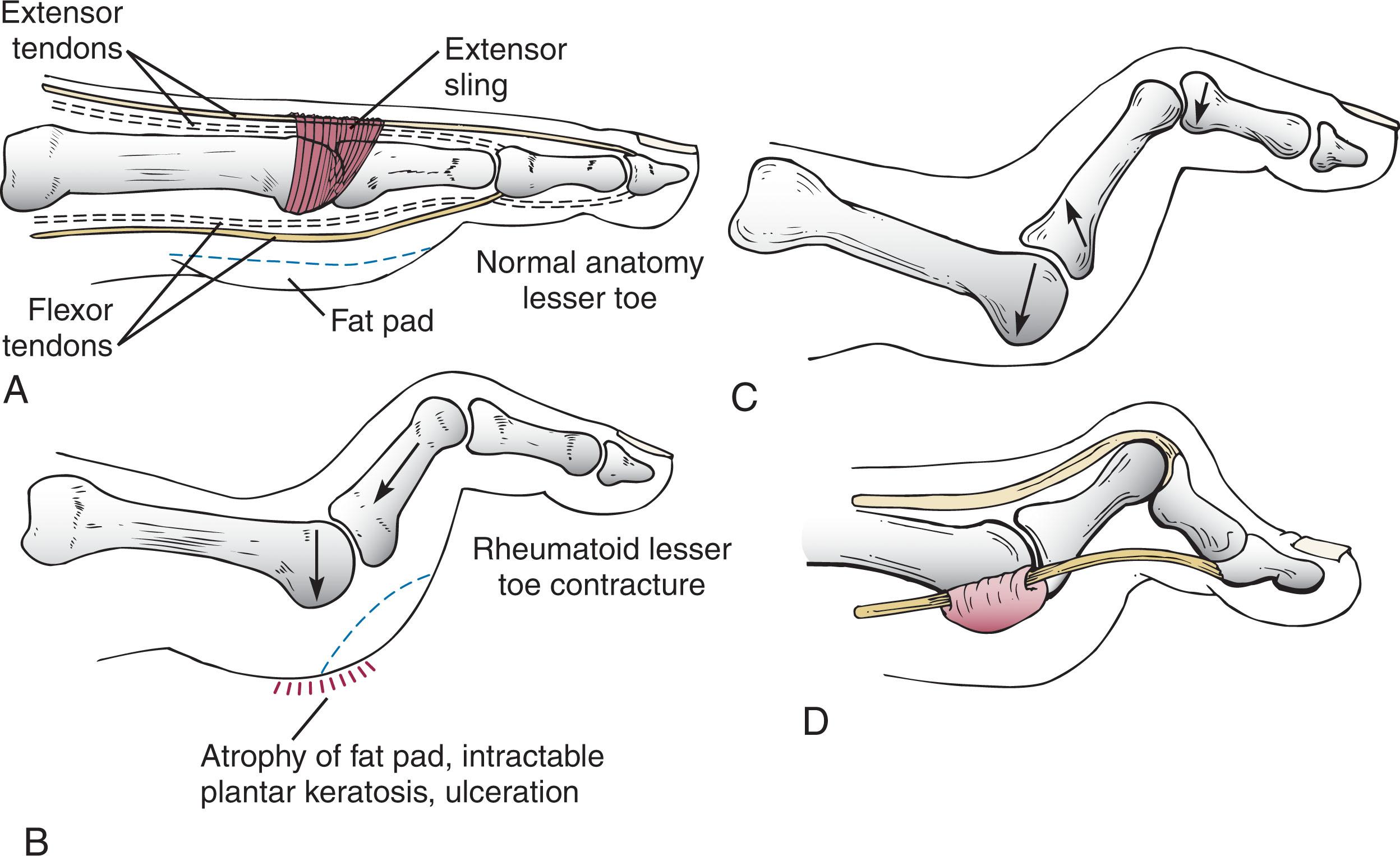
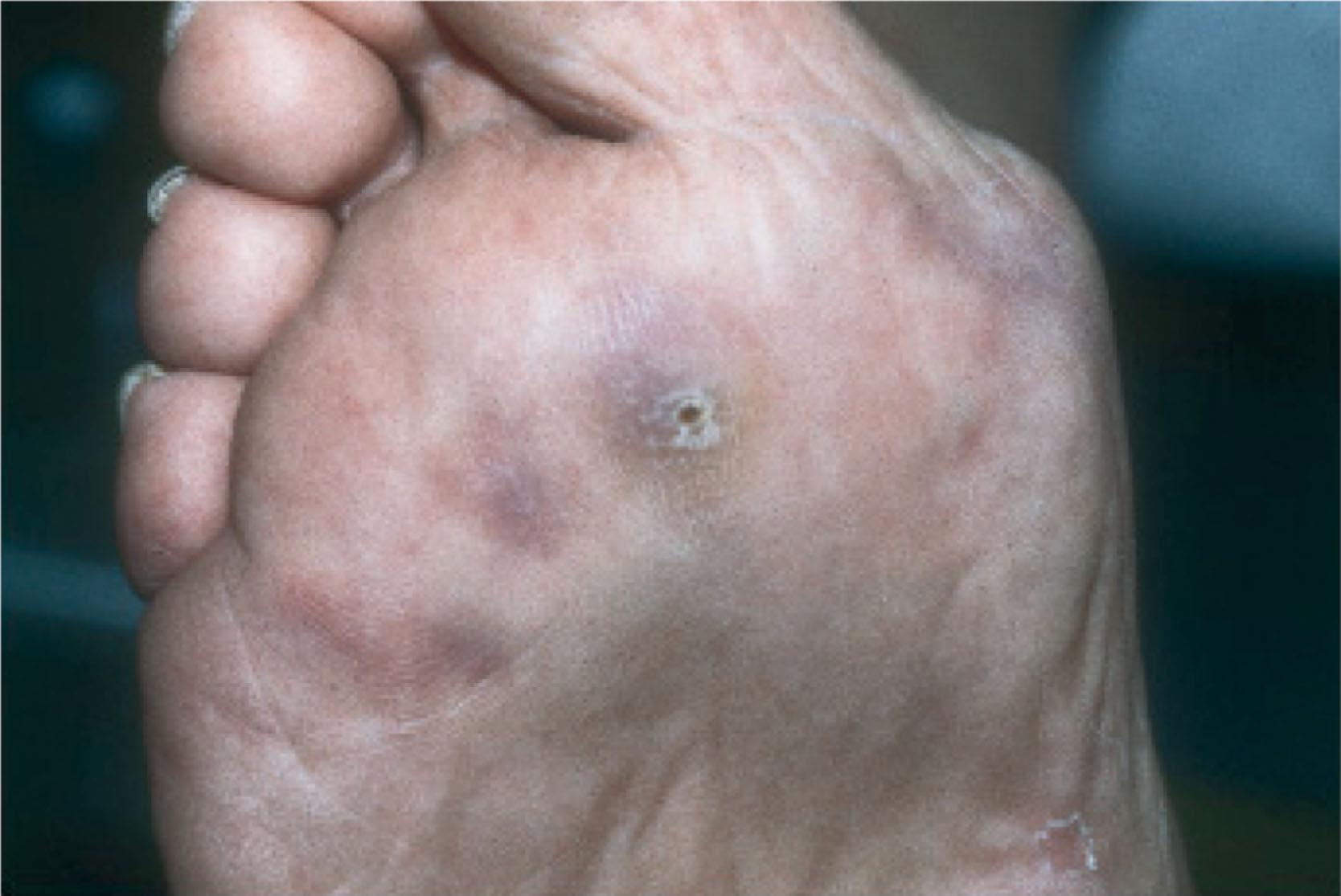
The rheumatoid plantar fat pad is significantly different than those of nonrheumatoid patients. Analysis with liquid gas chromatography demonstrates that the rheumatoid fat pad has a significantly higher ratio of saturated to unsaturated fat, as well as a higher viscosity. This is thought to reduce absorption of energy with foot strike, which may contribute to development of IPK lesions.
Subluxation and dislocation of the lesser toes creates an imbalance between the intrinsic and extrinsic muscles and gives rise to progressive hammering of the lesser toes. Occasionally, a swan-neck deformity of a lesser toe develops, but more often, a hyperextension deformity of the MTP joint occurs in combination with a flexion deformity of the proximal interphalangeal (PIP) and distal interphalangeal (DIP) joints (claw toe deformity). Because of severe contracture of the lesser toes, significant shoe-fitting problems result. Callosities can develop over the dorsal aspect of the PIP joint, causing areas of pressure. Large synovial cysts or rheumatoid nodules can develop in the forefoot and, when located on weight-bearing surfaces, lead to significant difficulty with ambulation. Although typically the lesser toes deviate in a lateral direction, medial deviation occasionally occurs. The resultant direction depends, to a great extent, on the direction in which the hallux deviates (varus or valgus).
Forefoot involvement in an early, frequent, and progressive finding in patients with rheumatoid arthritis. Michelson et al reported that within the first 1 to 3 years of rheumatoid arthritis, 65% of patients are noted to have MTP synovitis. With chronic rheumatoid arthritis, Vidigal et al and others have reported that approximately two thirds of patients develop subluxation and dislocation of the lesser MTP joints ( Fig. 21-25 ). Michelson et al and others have reported that the incidence of hammer toe or claw toe deformity of the lesser toes varies from 40% to 80%.
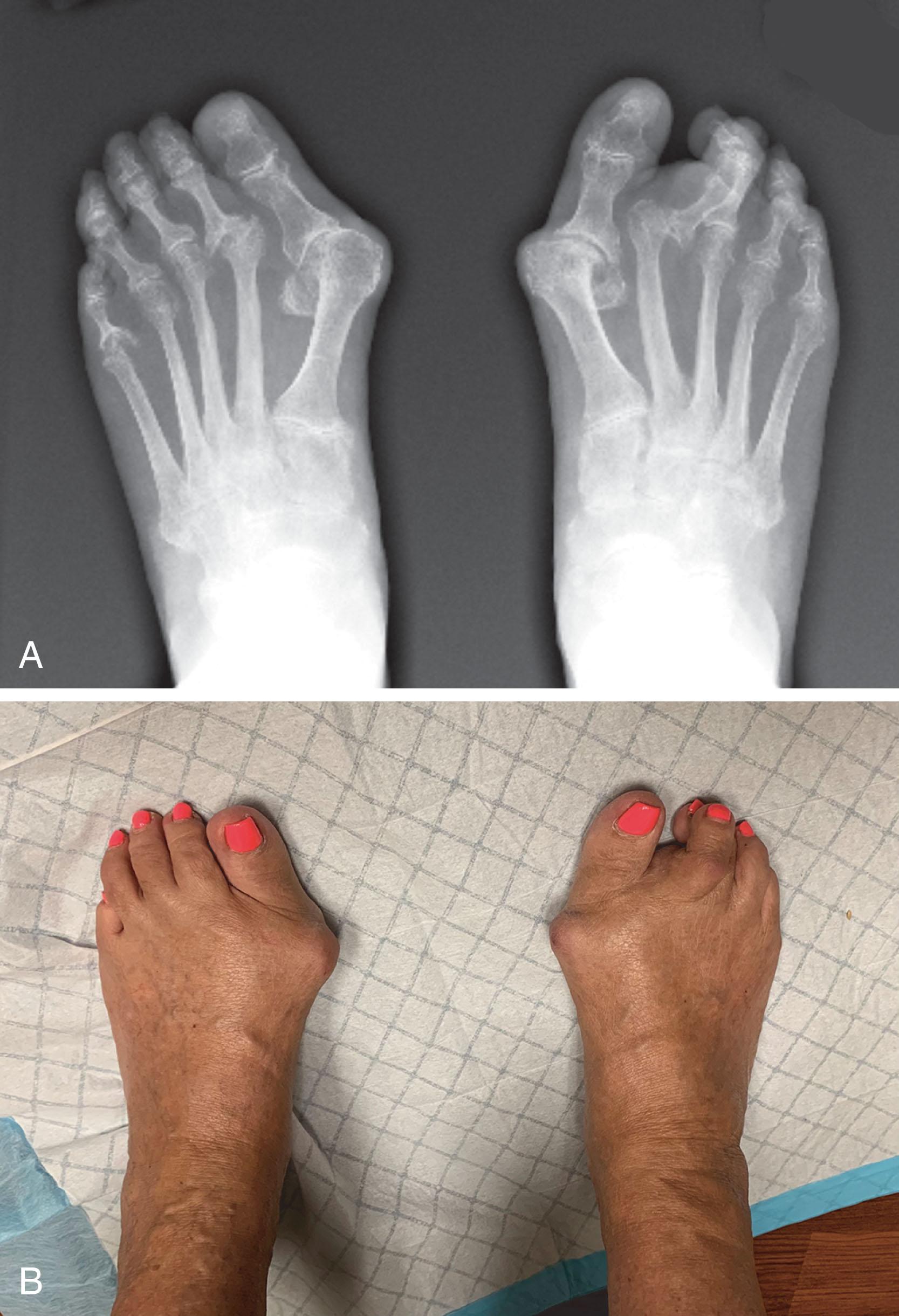
Hallux valgus increases in incidence and severity in the chronic stages of rheumatoid arthritis. Michelson et al and others have reported hallux valgus in 59% to 90% of patients with chronic rheumatoid arthritis. With progressive clawing of the lesser toes, little lateral stability is afforded to the great toe, and the hallux migrates laterally to a fixed position either under or over the second and third toes. Progression of the rheumatoid process includes destruction of articular cartilage and resorption of subchondral bone, which continues to destabilize the hallux. As the hallux valgus deformity worsens, the weight-bearing function of the first ray diminishes and a greater proportion of weight is borne on the lesser metatarsal heads.
With time, the total number of diseased forefoot joints increases, as does the severity of the disease. In a longitudinal study, van der Leeden et al studied newly diagnosed patients with rheumatoid arthritis over an 8-year span, specifically looking at clinical impairment and walking disability. On presentation, 67% of patients had clinically painful and swollen MTP joints, which decreased to 40% to 50% over a 2-year period, while being treated medically. Even though the clinical numbers appeared to stabilize, the severity of radiologic forefoot damage increased. Once forefoot disease is present, deformity tends to progress rapidly over time, especially in the absence of pharmacologic treatment.
The midfoot joints are also frequently affected by rheumatoid, leading to deformity, disability, and gait abnormality. Vidigal et al reported midtarsal joint involvement in approximately two thirds of patients with chronic rheumatoid arthritis. Chronic synovitis and eventual chondrolysis of the tarsometatarsal joints often occur with chronic disease.
Associated with this, flattening of the longitudinal arch occurs in approximately 50% of patients, and a valgus deformity of the hindfoot can occur. With disease progression, the talar head assumes a plantar medial position ( Fig. 21-26 ) as the soft tissue structures supporting the talar head become attenuated. This midfoot collapse may have a multifactorial etiology. Several reports have linked arthritis and ligamentous laxity to pes planus, although others have indicated posterior tibial tendon rupture as the source. In reality, all of the above likely contribute to the clinical picture.
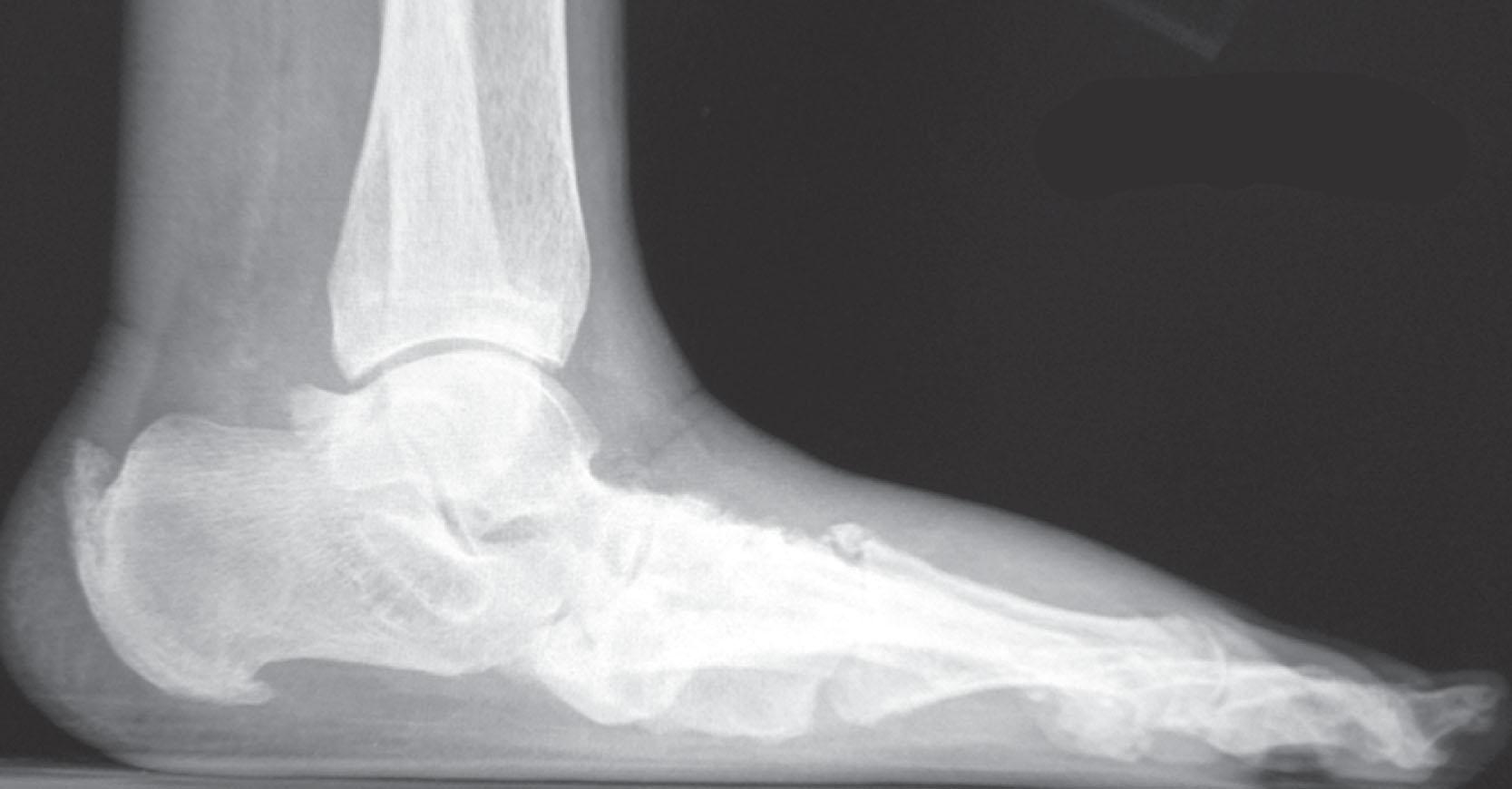
The resultant ambulatory pattern is a shuffling, flat-footed steppage gait. Fu and Scranton noted that with progressive rheumatoid arthritis the foot changes to a passive weight-bearing platform for ambulation.
Usually, because of the limitation of motion at the midfoot joints, a fibrous or bony ankylosis develops, but reduced motion is rarely restrictive. However, occasionally, the first MTC joint becomes extremely hypermobile, with subsequent loss of normal weight-bearing function. Resultant transfer metatarsalgia can occur from this hypermobility. Loss of the longitudinal arch on weight-bearing lateral radiographs is demonstrated by sagging at either the MTC or the naviculocuneiform articulation. Severe deformity can occur over time and make weight bearing almost impossible.
Hindfoot arthritis in patients with rheumatoid arthritis is less common than forefoot involvement and occurs with much longer duration of rheumatoid arthritis. Clayton reported that the forefoot was involved 10 times more often than the hindfoot. Vainio reported that 72% of women and 59% of men with chronic rheumatoid arthritis had involvement of either the midtarsal or the subtalar joint but that surgical intervention was relatively infrequent. Spiegel and Spiegel observed that in patients with rheumatoid arthritis of less than 5 years' duration, only 8% demonstrated hindfoot arthrosis, whereas in those who had had rheumatoid arthritis longer than 5 years, 25% were symptomatic.
With hindfoot involvement, a patient might misconstrue subtalar or transverse tarsal joint pain as “ankle” pain. Careful physical examination may be necessary to differentiate these symptomatic areas. Selective injections or imaging studies such as CT scan or MRI (or both) can provide conclusive information.
The underlying pathophysiology with hindfoot involvement relates to progressive destruction of the capsular and ligamentous supporting structures of the subtalar joint. Because subtalar joint function is intimately associated with transverse tarsal joint function, instability of these joints can result in altered function and gait. Often, the end result is a progressive pes planovalgus and hindfoot valgus deformities ( Fig. 21-27 ). Posterior tibial tendon dysfunction with rheumatoid arthritis can lead to a unilateral progressive flatfoot deformity as well. Flattening of the longitudinal arch also can develop secondary to naviculocuneiform joint deterioration or first MTC joint collapse. In some patients, severe valgus of the hindfoot may be associated with a concomitant valgus deformity of the ankle joint as well ( Fig. 21-28 ). Kavlak noted that patients often show an obvious hindfoot valgus position and that a varus hindfoot is seldom seen ( Figs. 21-29 and 21-30 ). Keenan et al reported that pes planovalgus deformities in patients with rheumatoid arthritis resulted from exaggerated pronation forces on the weakened and inflamed subtalar joint. They demonstrated with electromyographic studies that an increased period of activity of the tibialis posterior muscle occurred, which was interpreted as an “attempt to stabilize” an unstable foot.

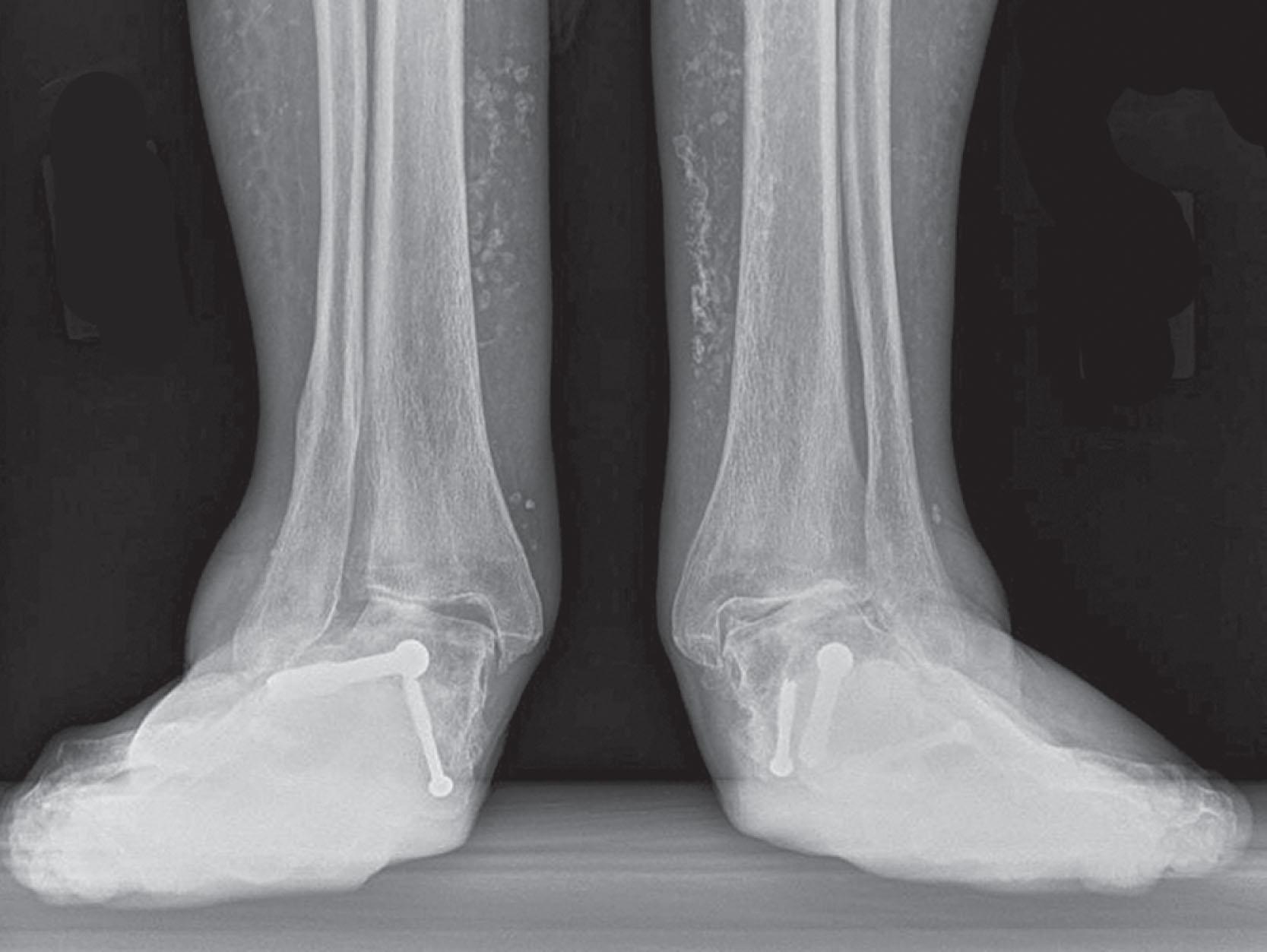
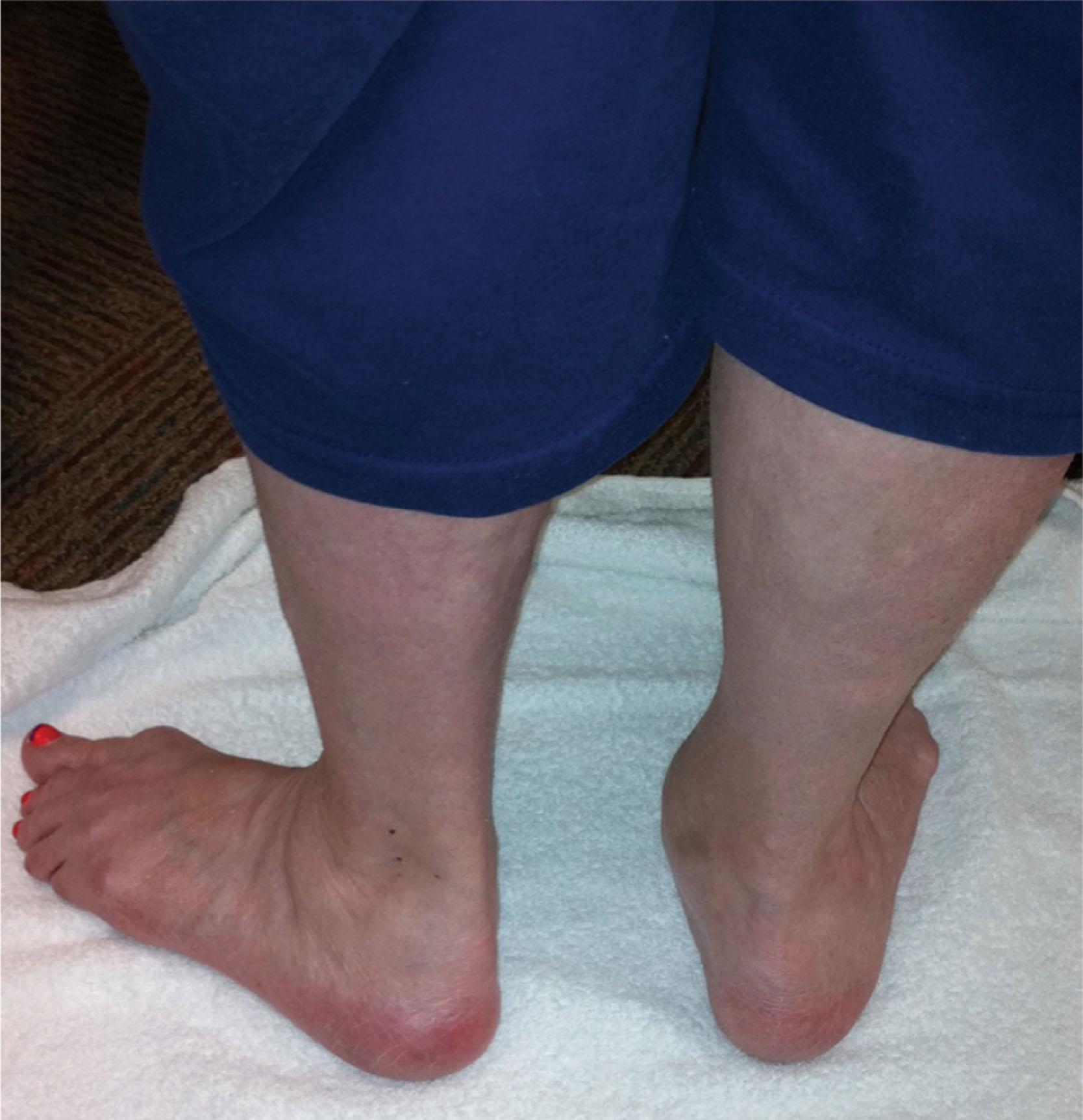
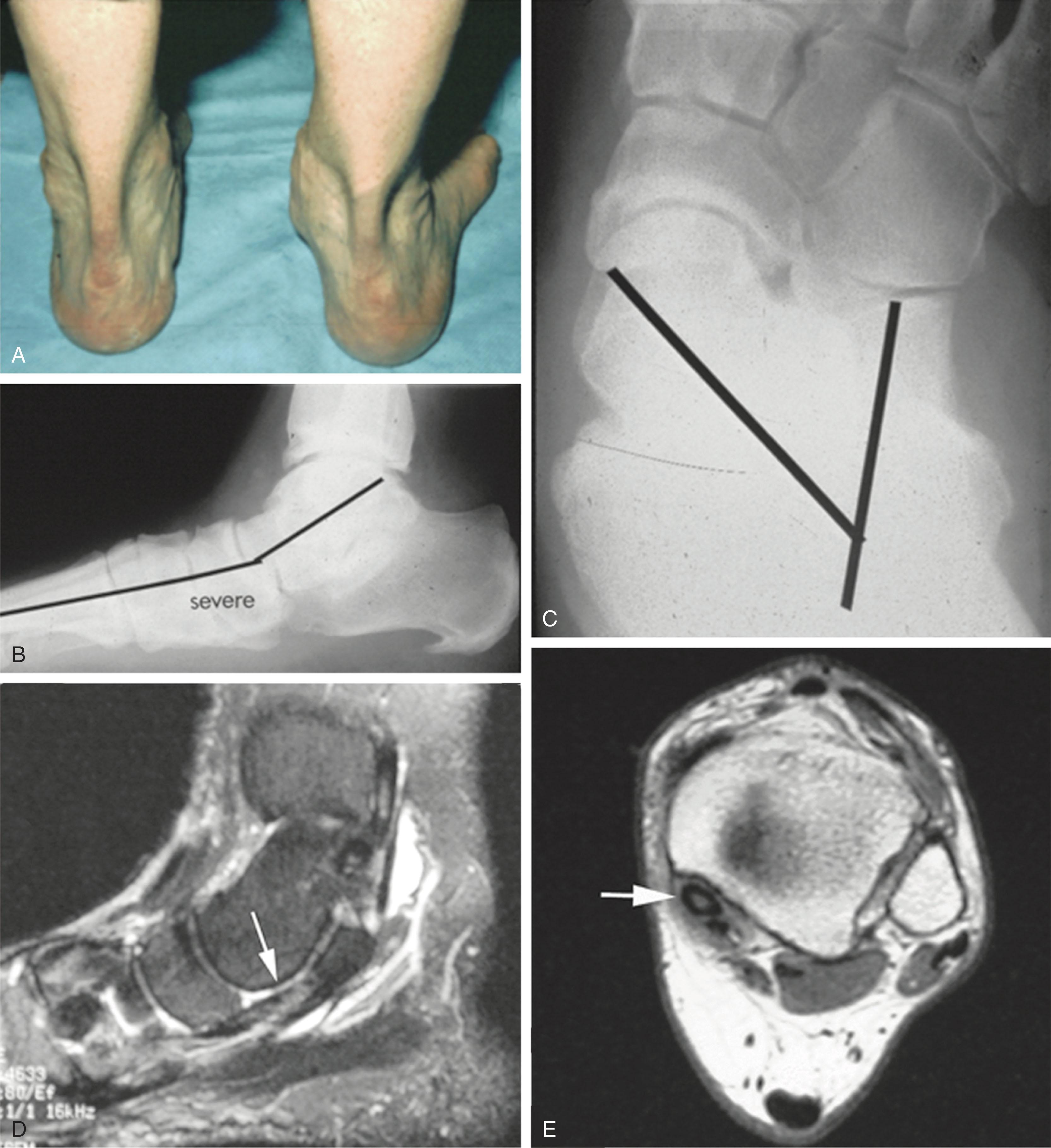
These deformities create a difficult management situation, with both ankle and hindfoot involvement. Bracing is difficult, and a pantalar fusion may be necessary to realign the foot but presents the patient with a difficult surgical recovery.
With severe, long-standing hindfoot deformity, an Achilles tendon contracture can develop. Although not a primary deformity, it occurs secondarily in relation to a chronic valgus deformity of the hindfoot. At the time of a triple arthrodesis, Achilles tendon lengthening may be necessary.
Gait analysis of patients with chronic rheumatoid arthritis when compared to those of nonarthritic subjects demonstrates delayed and reduced forefoot loading, resulting in a shorter stride length. This results in diminished walking speed, cadence. A decrease in ankle power is also noted. This effect may be related to pain in the forefoot that, in turn, causes a reduction of the functional lever arm of the foot during push-off. Platto et al reported an association between impaired ambulation and foot deformity. They observed a greater association between hindfoot disease and gait impairment compared with forefoot disease.
The classic radiographic signs of rheumatoid arthritis are that of a synovial inflammatory disease. Hyperemia and acute synovitis leads to periarticular osteoporosis, and early radiographic examination might reveal only soft tissue swelling and diffuse juxtaarticular osteoporosis. In contrast, normal bone mineralization is usual in psoriasis, reactive arthritis, ankylosing spondylitis, and crystalline arthropathies. Synovial inflammation eventually leads to marginal cortical erosions at the reflection of synovium and capsule attachment ( Fig. 21-31 ). These peripheral erosions eventually progress to central erosions with resultant joint space narrowing, subluxation, and dislocation. Eventual destruction of the articular cartilage occurs as the rheumatoid pannus extends toward the cartilaginous surface. The articular cartilage is thought to be destroyed by proteolytic enzymes, resulting in joint space narrowing.
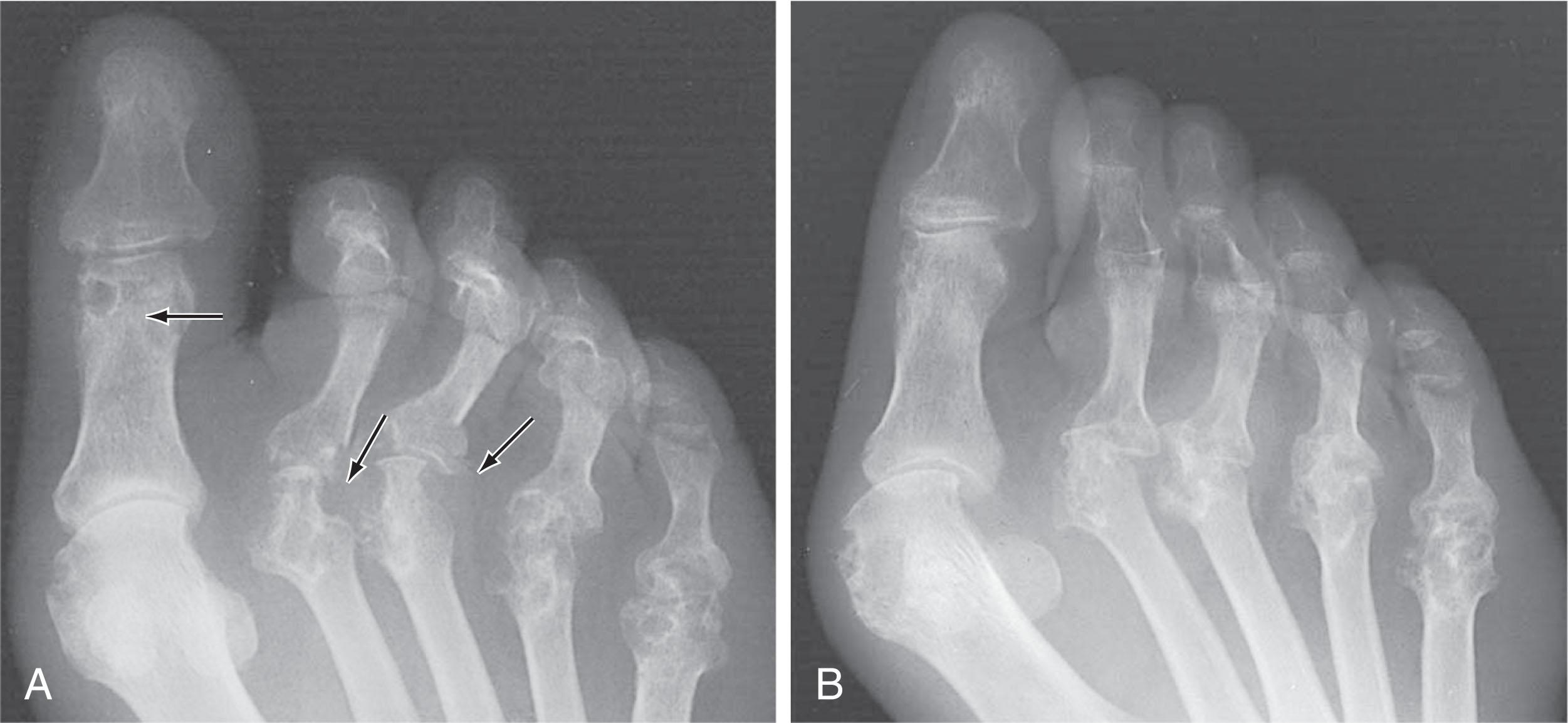
Gold and Bassett noted that rheumatoid arthritis tends to strike earliest at the first, fourth, and fifth MTP joints. They reported that the medial aspect of the first, second, third, and fourth metatarsals and the lateral aspect of the fifth metatarsal were involved initially. The earliest visible erosions probably occur on the lateral aspect of the fifth metatarsal. The IP joints are typically spared except for the hallux. Of interest, in patients with preexisting periarticular erosions, the erosions progress with time, whereas in those patients with preexisting joint space narrowing, it is the joint space narrowing that progresses with time. These two processes seem to be independent of one another.
Midfoot and hindfoot changes include midfoot collapse, pes planus, and subtalar sclerosis. Localized inflammation in the areas of the retrocalcaneal bursa and at the attachment of the Achilles tendon and plantar aponeurosis are common with long-standing disease ( Fig. 21-32 ).

Gold and Bassett reported the talonavicular joint is typically the first tarsal joint to be involved. Although radiographic midfoot arthritic changes are seen in up to 62%, clinically, these are far less symptomatic (27%). In a series of patients with rheumatoid arthritis who were evaluated with CT scans, Seltzer et al noted talonavicular joint involvement in 39%, calcaneocuboid involvement in 25%, and subtalar involvement in 29%.
Radiographically, the subtalar joint is involved to a lesser extent than the midfoot, with changes noted in 32% to 42% of patients. Only 21% of rheumatoid arthritis patients actually have clinical symptoms in the hindfoot. Rarely are all three of the hindfoot joints simultaneously affected.
Hattori and colleagues noted two distinct patterns of pes planovalgus deformities in the rheumatoid foot. One group demonstrated degenerative changes in both the subtalar and talonavicular joints, with the talar head subluxated plantarward in relation to the navicular. A second group showed only subtalar joint involvement. Neither group demonstrated involvement of the calcaneocuboid joint.
Lindqvist et al noted more rapid radiographic progression in those patients with higher levels of inflammatory markers, such as sedimentation rate and rheumatoid factor (RF). Another report suggested that 59% of 190 patients with early rheumatoid arthritis could be classified as nonprogressive based on radiographic joint changes and that radiographic progression may be slowed by treatment with disease-modifying antirheumatic drugs (DMARDs) and other pharmacologic agents, including antibiotics (sulfonamides, doxycycline), salicylates, cytotoxic drugs (methotrexate, leuprolide acetate, cyclophosphamide), NSAIDs, corticosteroids, and cytokine inhibitors (etanercept, infliximab).
In patients with nonspecific pain or diffuse foot pain, or both, with no visible radiographic findings and subtle or minimal clinical findings, a technetium-99 ( Tc) bone scan can help to localize disease ( Fig. 21-33 ).
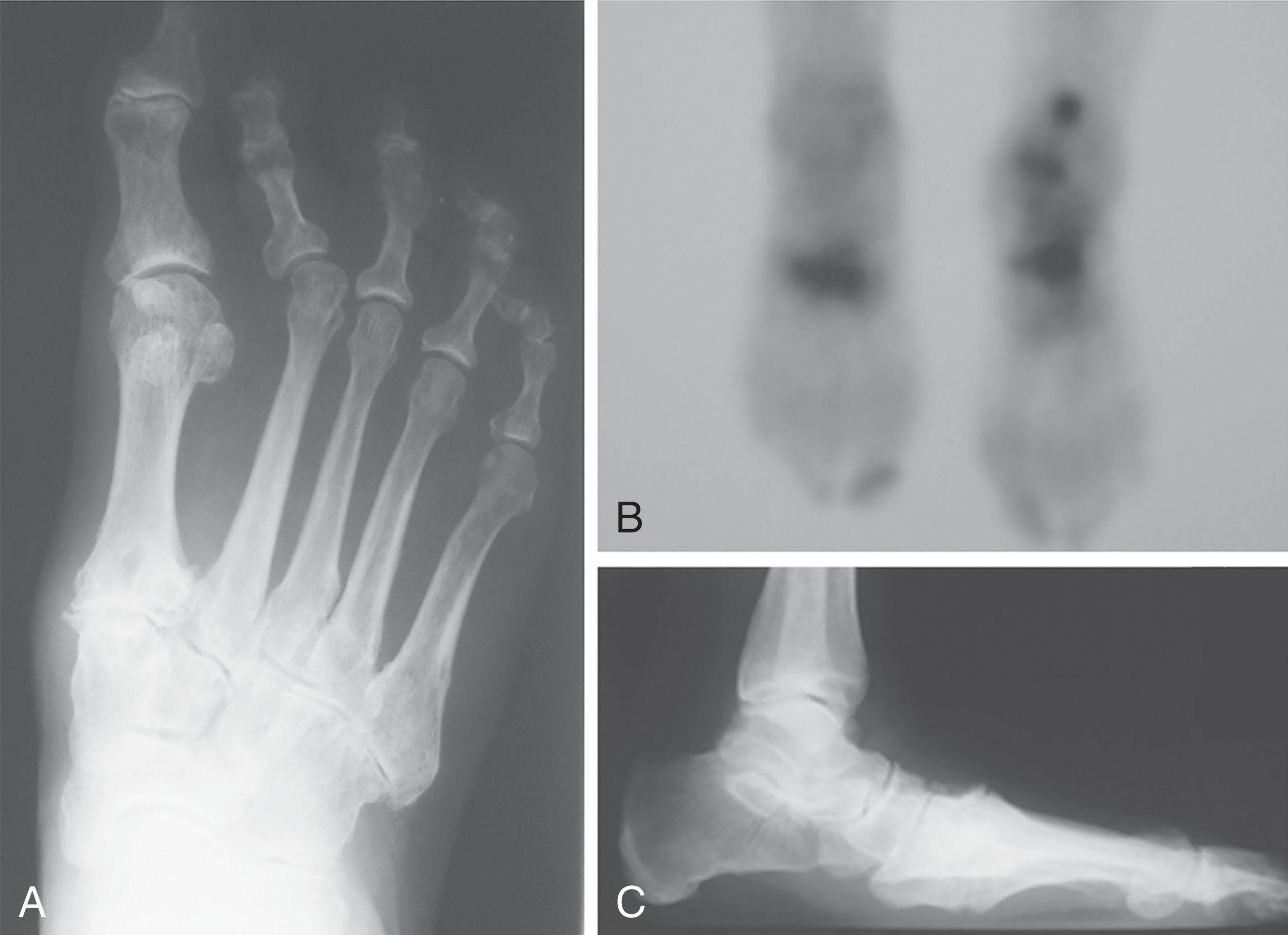
MRI is increasingly used to evaluate forefoot symptoms and may be helpful in diagnosing joint erosion, chondrolysis, and other specific features of various inflammatory diseases. MRI is particularly sensitive early in the disease process. Boutry et al noted MRI findings consistent with synovitis in up to 97% of patients with early rheumatoid arthritis ( Fig. 21-30D and E ).
The histopathology of bone lesions in rheumatoid arthritis is characterized by fibroblast proliferation; infiltration of macrophages, lymphocytes, and plasma cells; collagen deposition; and new bone formation. The hyaline cartilage surface is usually necrotic. Pannus (a collection of inflammatory cells, fibroblasts, synovium, and granulomatous tissue) is absent except at the margins of the capsular attachments. The process appears reparative in nature, but the inflammatory cell infiltrate or aggregate around small blood vessels in deeper bone marrow regions helps to confirm the diagnosis. The most common soft tissue lesions are rheumatoid nodules, which often form subcutaneously and comprise lymphocytes and plasma cells. Rheumatoid nodules generally form in areas of bony prominence, such as the ulnar border of the forearm and elbow, the occiput, the lumbosacral area, and the plantar foot ( Fig. 21-34 ); however, they can also be found in the abdominal and thoracic cavities.
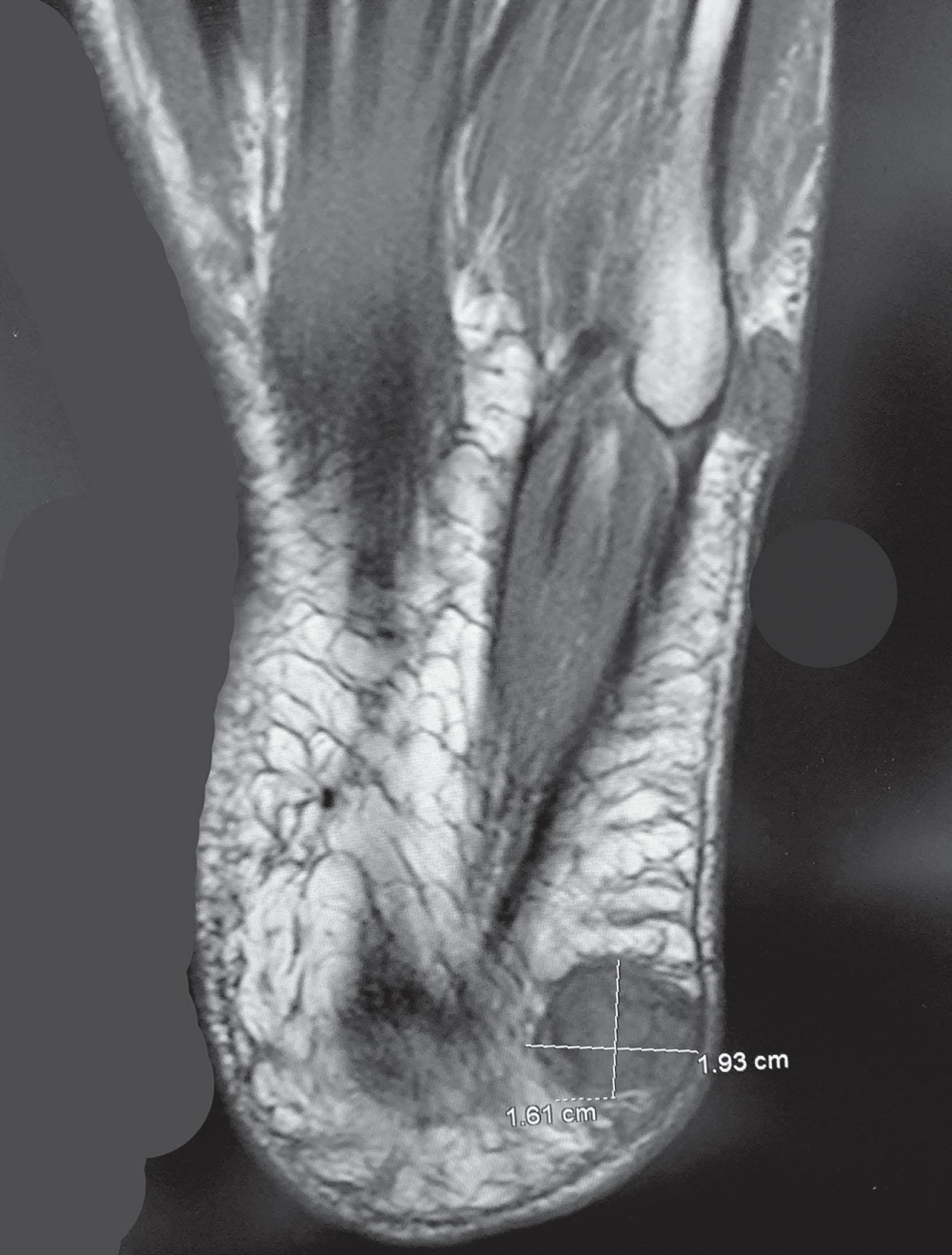
In a study of 223 patients with seropositive rheumatoid arthritis, these rheumatoid nodules were histologically characterized into three classic zones: a necrotic central area, a surrounding wall of cells, and a marginal zone associated with the subcutaneous tissue or joint capsule. Such nodules appeared to develop after 4 or more years of disease duration and were associated with pain and deformity in nearly 70% of patients studied. Such necrosis or nodule formation may be an important factor that worsens the clinical prognosis in seropositive patients.
At the microscopic level, the macrophage appears to play a key role. Radiologic progression of disease directly correlates with the number of macrophages lining the diseased joint within the cartilage–pannus interface ( Fig. 21-35A and B ). This appears to be explained by the fact that once activated, macrophages, in turn, activate osteoclasts and other “downstream” cells to produce IL-1 and TNF. These cytokines stimulate osteoclasts to produce collagenase, which resorbs bone and destroys cartilage.
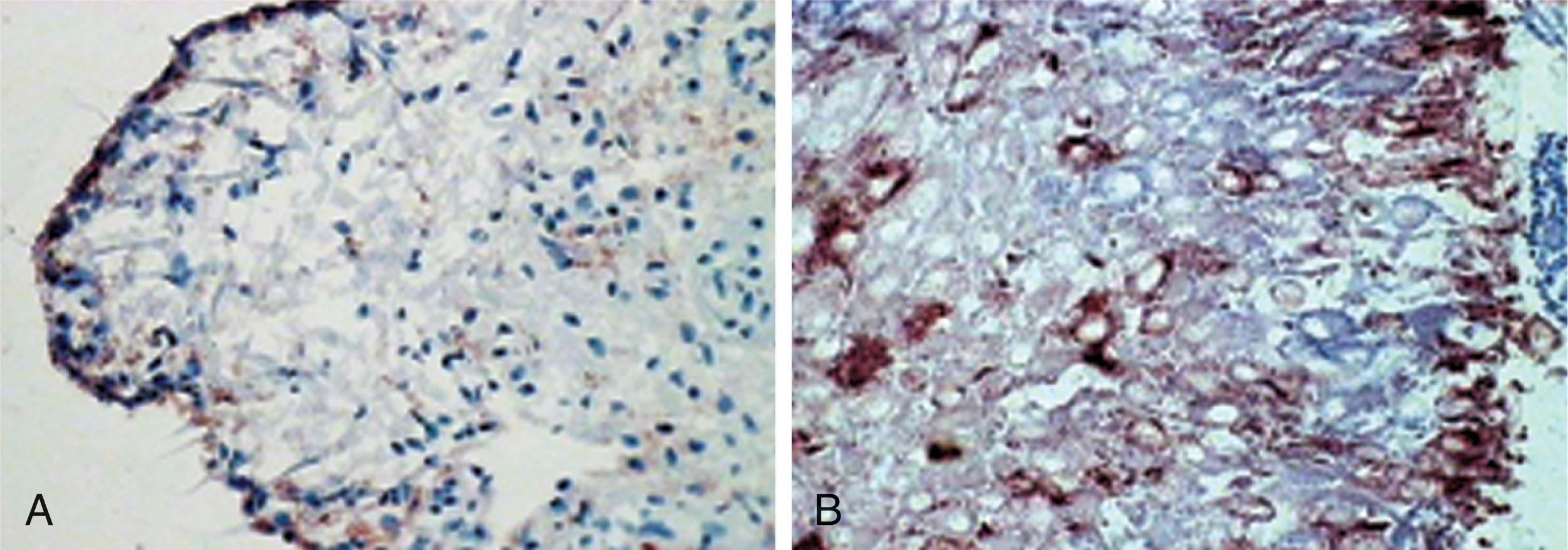
Rheumatoid arthritis appears to affect striated muscle as well as the joint. Using electron microscopy to evaluate muscle specimens from RA patients, de Palma et al illustrated several distinct differences from normal muscle. The myofibrils demonstrated wider separation, with dilation of the sarcotubular system, and flaking of the myofibrils.
Recognition of these microscopic characteristics has led to advances in the treatment of rheumatoid arthritis, including pharmacologic agents directed against macrophage-produced cytokines.
The diagnosis of rheumatoid arthritis is based on a combination of clinical evaluation, radiographic examination, and laboratory testing.
The American College of Rheumatology suggests that at least four of seven criteria be present to diagnose rheumatoid arthritis ( Box 21-1 ).
Morning stiffness in and around the joints for greater than or equal to 1 hour*
Swelling of the soft tissues around three or more joints*
Swelling of the soft tissue of the wrist, hand, or finger joints*
Symmetric joint swelling/arthritis *
* Symptom present for more than 6 weeks.
Subcutaneous rheumatoid nodules
Elevated levels of rheumatoid factor in the blood
Radiographic changes of erosions/periarticular osteopenia in the hand or wrist joints
Serologic testing is positive for RF 70% to 90% of the time in those with rheumatoid arthritis. RF is an immunoglobulin M (IgM) antibody directed against Fc portion of the patient’s own immunoglobulin G (IgG) antibodies and is thought to be part of a normal immune response that is exaggerated in rheumatoid arthritis. Elevated RF titers correlate proportionally with more severe disease. However, RF may be falsely negative, and several other diseases may have a positive RF, including systemic lupus erythematosus (SLE), Sjögren syndrome, myositis, hepatitis C, cirrhosis, syphilis, and tuberculosis. Anticitrullinated protein antibody (ACPA) is another autoantibody frequently found in patients with rheumatoid arthritis that may be even more sensitive than RF.
An appreciation of the clinical course of rheumatoid arthritis is essential in the decision-making process of developing a treatment program. Nonetheless, initial orthopaedic treatment is directed toward pain relief, prevention of deformity, correction of deformity, preservation, and restoration of function. Medical management throughout the entire disease process includes pharmacologic treatment, which has been shown to improve ambulatory capacity.
Optimal treatment for patients with rheumatoid arthritis requires cooperation of both medical and surgical interventions. With a combined approach and with newer biologic disease-modifying agents, future complications may be less prevalent.
Pharmacologic agents that reduce inflammation and relieve pain facilitate the treatment of rheumatoid arthritis. For mild cases, NSAIDs are the first line of defense. The occasional judicious use of an intraarticular corticosteroid injection may be beneficial, but systemic oral steroid therapy is used less commonly because of the well-known deleterious side effects of chronic corticosteroid use. As symptoms progress, DMARDs are often added to the treatment regimen. These include methotrexate, sulfasalazine, leflunomide, and hydroxychloroquine. Interestingly, the advent of DMARD therapy has coincided with the declining incidence of RA patients requiring orthopaedic surgery. However, side effects may develop with chronic use. For example, cutaneous ulcers that were likely related to methotrexate toxicity have been reported to develop spontaneously in patients with rheumatoid arthritis.
Biologic response modifiers (BRMs) have shown promise in moderate-to-severe cases. These modern pharmacologic agents include infliximab (Remicade), etanercept (Embrel), and adalimumab (Humira). All three medications act as TNF-α inhibitors. Anakinra (Kineret), the IL-1 receptor antagonist, has also shown promising results, while the IL-6 receptor antagonist tocilizumab (Actemra) inhibits the progression of foot erosions. Lipsky et al reported that the combination of methotrexate and infliximab halted progression of joint damage over the course of 1 year. Bowen et al noted improvement in foot pain and disability after 12 weeks of anti–TNF-α therapy.
Several additional studies support the beneficial effects of anti–TNF-α therapy, particularly when combined with methotrexate. Smolen et al also noted that the use of infliximab with methotrexate is more effective at halting space narrowing and periarticular erosions than methotrexate therapy alone. Despite these encouraging results, 99% of patients taking anti–TNF-α therapy in a large epidemiologic study noted current foot pain. These findings could create a larger pool of patients with secondary osteoarthritis. In turn, this could lead to a change in the use of specific orthopaedic procedures from those that are typically joint destructive to those that are joint sparing for many patients with rheumatoid arthritis who have nonprogressive disease.
Gene therapy trials have also been conducted in patients with rheumatoid arthritis. Evans et al reported on retroviral transfection of metacarpophalangeal joint synoviocytes with an IL-1 receptor antagonist. Further investigation along these lines may reveal exciting treatment options for patients with rheumatoid arthritis.
Jeng and Campbell noted that intraarticular steroid injections appear to be beneficial for hindfoot and midfoot joints but caution that there are insufficient data to support safe use in forefoot joints.
For those patients taking long-term steroid therapy, intravenous hydrocortisone is used perioperatively to prevent adrenal crisis. The current authors follow the recommendations of Mackenzie and Sharrock, administering 100 mg of hydrocortisone intravenously to those patients who have taken oral steroids for more than 2 weeks, or for those who are on steroids for adrenal insufficiency.
To date, perioperative guidelines for the use of BRMs have not been established. Although increased infection rates remain a concern, a paucity of randomized controlled data prevents solid conclusions. The British Society for Rheumatologic Guidelines recommends withholding anti–TNF-α therapy for 2 to 4 weeks before surgery and reinstating it after the wound has healed. Multiple studies have examined the effects of perioperative methotrexate use and postoperative wound complications. Although some suggest a link between methotrexate use and postoperative infection, other more powerful studies suggest that this correlation may be exaggerated. The current authors do not routinely stop methotrexate use in the perioperative period. Studies with leflunomide show contrasting results. Fuerst et al reported an increased rate of wound complications (40.6% vs. 13.6%) in patients taking leflunomide compared with those taking methotrexate. In contrast, Bibbo et al showed no increase in infection with the use of leflunomide. Although a helpful part of pharmacologic therapy, DMARDs may cause bone marrow suppression and hepatotoxicity; thus, laboratory screening should be done before surgical intervention in patients receiving DMARD therapy.
Conservative care for midfoot and hindfoot degeneration includes rest to relieve swollen and inflamed joints, minimizing weight bearing during acute flare-ups; cast immobilization; padding; roomy footwear; and custom-made longitudinal arch supports. With instability, a polypropylene AFO can provide some relief ( Fig. 21-36A and B ).
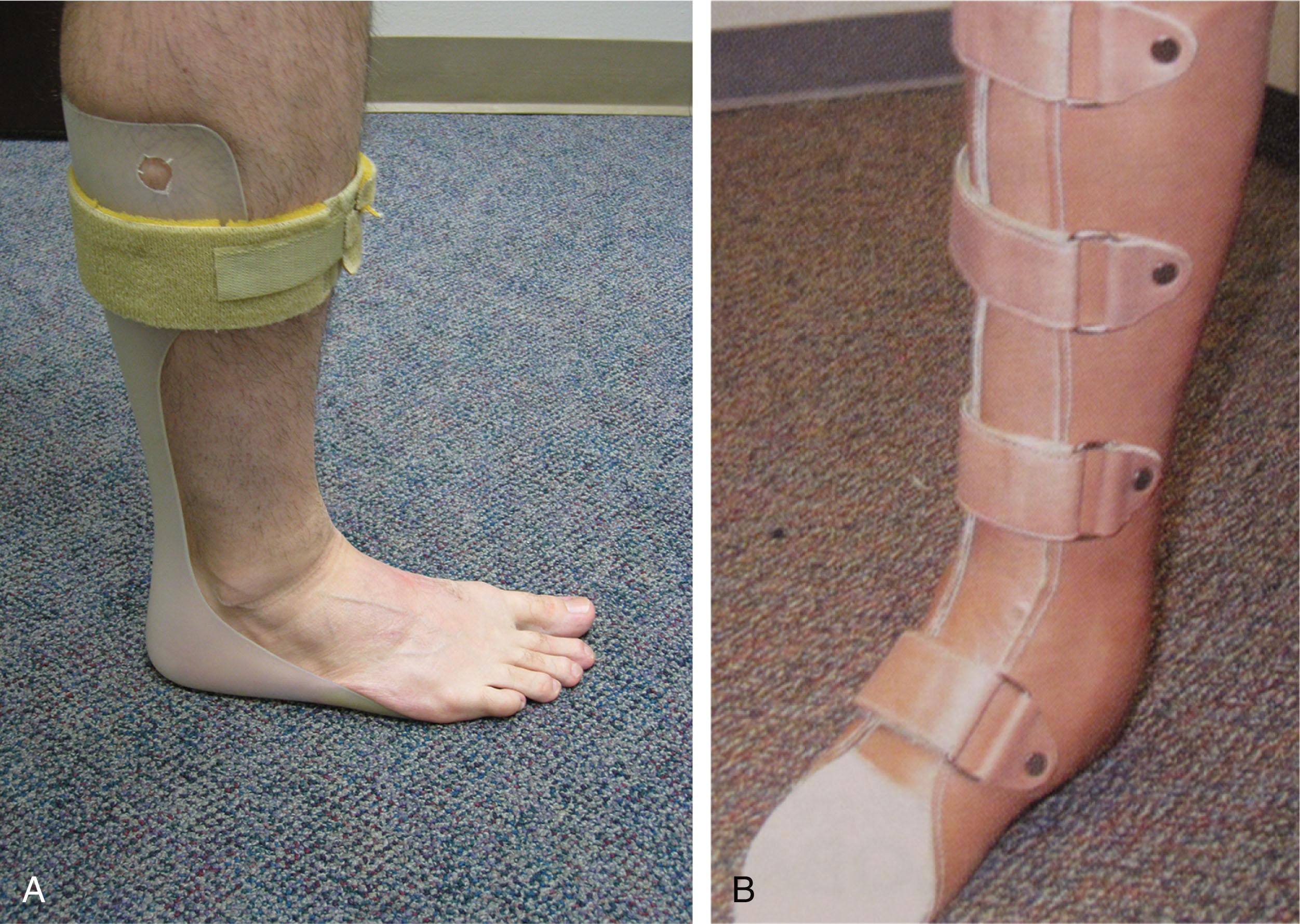
The most important aspect of early nonsurgical care is wearing pain-relieving footwear. A carefully placed metatarsal pad just proximal to an IPK lesion or an area of MTP joint tenderness can relieve discomfort associated with increased pressure. Excavating the insole beneath a pressure area can also decrease symptoms. Many patients with mild-to-moderate rheumatoid involvement of the foot can be fitted with a broad-toed, soft-soled shoe. Orthotic devices redistribute weight-bearing forces and tend to decrease pressure areas, decrease shearing forces, and support unstable joints. A Plastizote liner or viscoelastic insole can relieve plantar pain in a patient with an atrophied plantar fat pad or intractable plantar keratoses. With significant lesser-toe contractures, extra-depth shoes can help accommodate more severe deformities. Although a Plastizote liner can accommodate significant forefoot deformities, it commonly needs to be replaced every few months as the insert bottoms out. Custom orthotics that incorporate a metatarsal dome pad may be more effective in reducing metatarsalgia and pressure beneath the first and second metatarsal heads.
There have been several studies that evaluated the use of specific custom orthotics or shoes for the treatment of rheumatoid foot deformities. Woodburn et al found a 19% reduction in pain, 31% reduction in disability, and 14% reduction in functional limitation with the use of custom rigid orthotics. Chalmers et al reported that semirigid orthoses had a significant effect on pain reduction, and soft orthoses and supportive shoes had little or no effect. None of these orthoses had any effect on reduction of joint synovitis. Mejjad et al noted that, with 1 month of use, custom orthotics reduced pain but had no effect on gait, whereas Kavlak et al found that, at 3 months of use, custom orthotics not only reduced pain but improved gait and stride length. Similarly, Tenten-Diepenmaat and colleagues noted that optimizing in-shoe plantar pressure measurements can lead to medium to large improvements in pain and physical function. As a general rule, orthotics should conform to the patient's foot with the goal of pain reduction and pressure distribution. Some believe that a soft orthotic should be used with an inflexible foot and that a rigid orthotic should be used for a supple one.
Moncur and Ward studied 25 patients with rheumatoid arthritis and found that 80% improved their walking ability by using custom heat-moldable shoes. However, others have noted that wearing such shoes is distasteful and uncomfortable for these patients.
Jannink et al evaluated the methodology of 11 randomized, controlled clinical trials that had studied the effect of orthopaedic shoes and orthoses. The authors reported that although all 11 studies demonstrated the effectiveness of their products, the studies evaluated did a relatively poor job of examining usability, efficiency, satisfaction, and reliability of patient use. It appears that orthoses designed to support rheumatoid arthritic foot deformities and to provide pain relief might yield some benefit, but patient satisfaction, usability, and the specific indications for a specified device remain vague, so specific indications are yet to be determined.
Soft-soled, rocker-bottom shoes decrease stress on the metatarsal and the hindfoot region. In addition, Cho et al found no difference between groups of patients wearing rocker-bottom shoes compared with those wearing custom orthotics.
The reported effect of in-office plantar callosity shaving or debridement is temporary and appears to decrease substantially within a week after debridement. At best, plantar callosity shaving offers temporary relief before definitive surgical treatment ( Fig. 21-37 ).
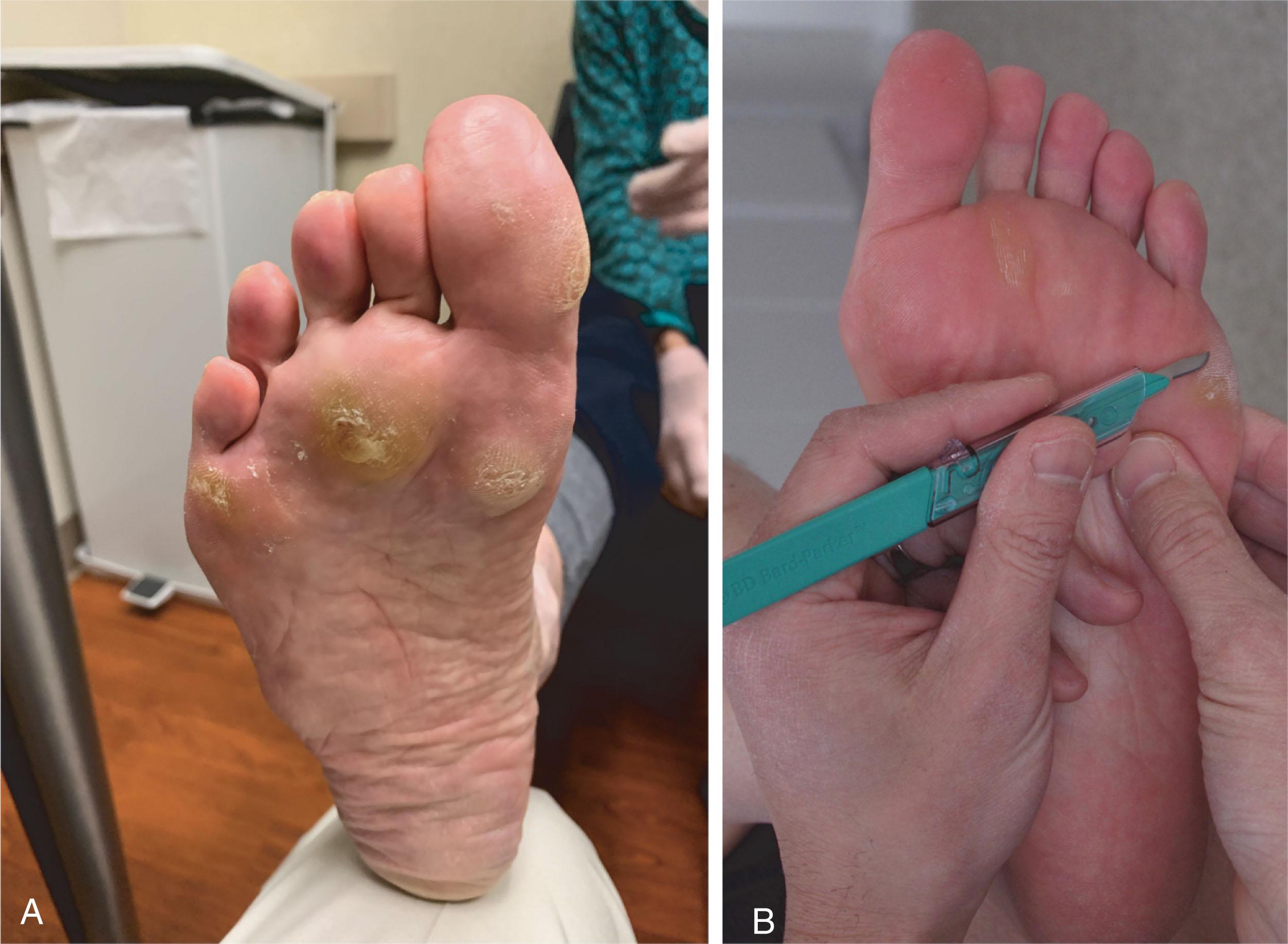
Patients should be instructed in foot care and careful observation of skin for potential breakdown. Bracing with an AFO may be necessary when foot and ankle pain becomes refractory to other methods of treatment. A molded leather ankle brace or an Arizona brace with steel stays can be worn inside a shoe and can provide significant ankle and hindfoot support ( Fig. 21-38 ).
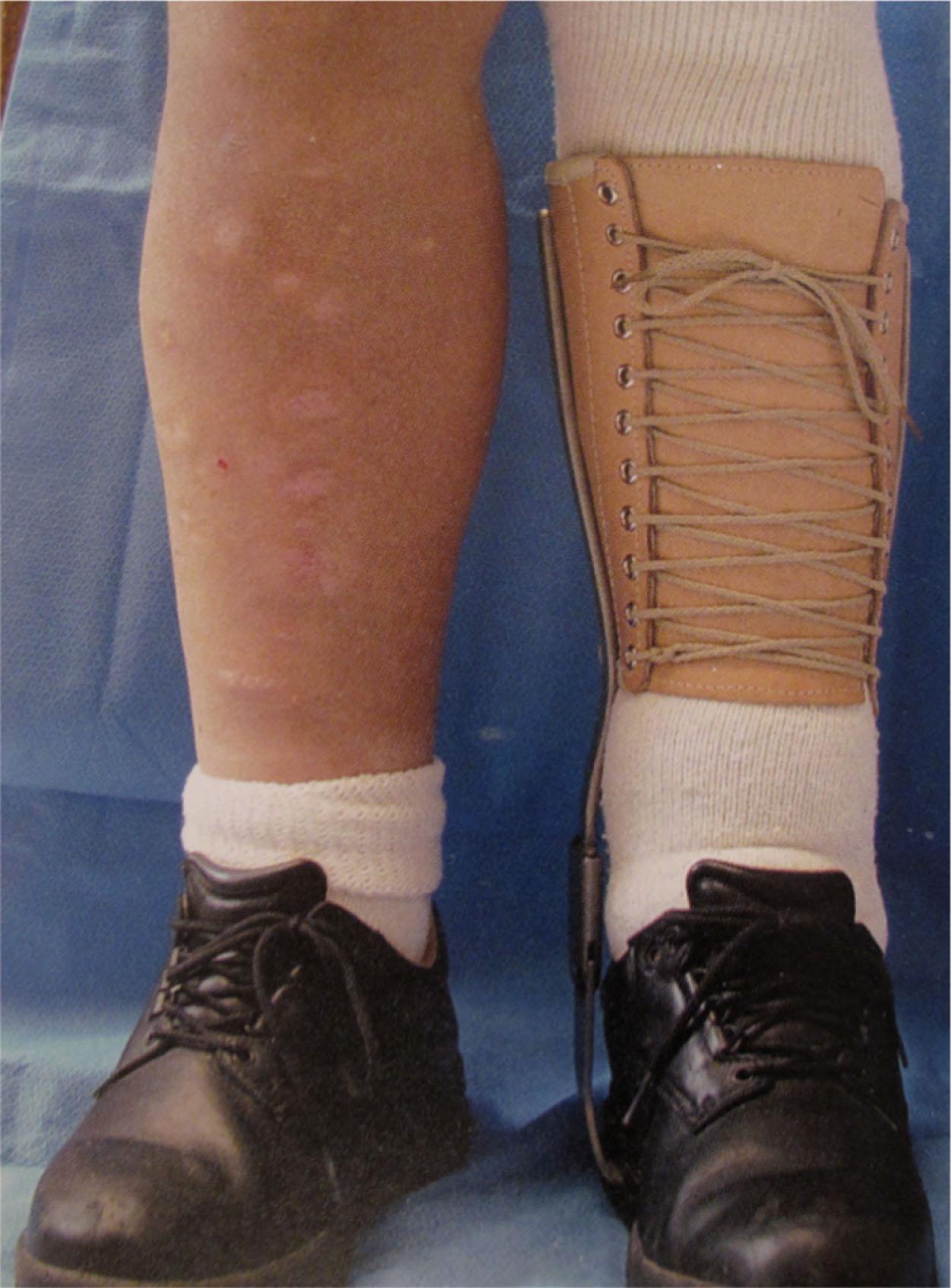
Physical therapy can be helpful in treating patients with foot problems associated with rheumatoid arthritis. Contrast baths may be used to decrease swelling and inflammation, although in the presence of the Raynaud phenomenon, they may be contraindicated. Stretching exercises for a contracted Achilles tendon and passive manipulation of the ankle and hindfoot can help to restore or maintain motion. Maintaining range of motion at the MTP joint and IP joints in the presence of acute rheumatoid arthritis may be aided by active or passive manipulation. Muscle strengthening and conditioning may be helpful in maintaining ambulatory capacity. In addition, exercise in early rheumatoid arthritis has been shown to enhance neuromuscular performance without an obvious negative effect on disease activity or joint disease. Limitation of ambulation during acute episodes, exercises, and stretching of involved joints are all important physical therapy modalities in maintaining function in the patient with chronic rheumatoid arthritis.
With the increasing involvement of numerous lower extremity joints, gait training is occasionally necessary to maintain ambulatory independence. The use of ambulatory aids, such as canes and crutches, can reduce weight-bearing stress, but this may be done at the expense of the upper extremities. With significant upper extremity involvement, platform crutches or canes with special handgrips may be necessary.
Lower extremity stress fractures may also arise as a complication of conservative treatment. In the cavus foot, the lateral metatarsals have a higher frequency of fracture, although the medial metatarsals are more likely to fracture in a planus foot. Valgus deformity of the ankle predisposes to fibular fractures. Calcaneal stress fractures may also occur.
When progressive deformity occurs or unrelenting pain is refractory to conservative treatment, surgical intervention may be necessary. Medical management should continue throughout the progression of the rheumatoid disease process. Surgical procedures may be indicated depending on the severity and progression of the inflammatory process. A monocyclic disease process infrequently requires extensive surgery, whereas a polycyclic or progressive process increases the risk of later surgical treatment ( Fig. 21-39 ).
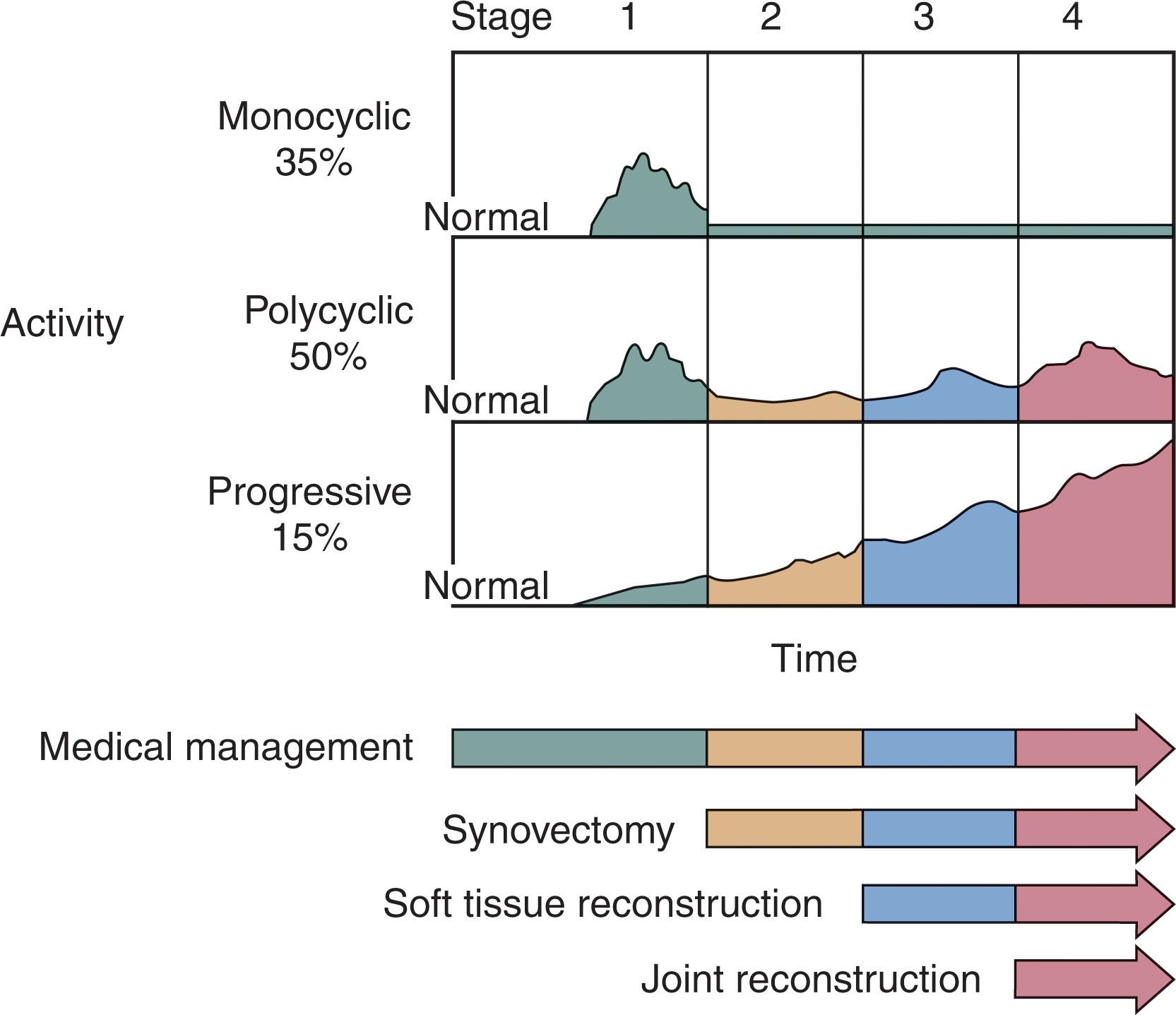
The precise timing of surgical intervention for the patient with rheumatoid foot and ankle deformities varies significantly and must be individualized for each patient. During the proliferative phase of synovitis, a synovectomy of an involved joint may slow the progression of the rheumatoid inflammatory process. For symptomatic synovitis without significant malalignment or joint disease, open or arthroscopic synovectomy of the hindfoot or transverse tarsal joints may provide temporary relief ( Fig. 21-40A and B ).

With progressive collapse of the longitudinal arch, early surgical intervention can prevent significant hindfoot deformity. Furthermore, an attempt should be made to prevent loss of ambulatory capacity with progression of the disease over a long period. Surgical reconstruction to maintain ambulation is important. Surgical intervention may be interspersed with periods of conservative care so that numerous surgical procedures are not clustered during a short time.
Preoperative assessment, including attention to the vascular supply of the foot, is important. Although rheumatoid vasculitis is uncommon, it can present an increased risk to wound healing with surgery. The diagnosis of vasculitis is difficult, but nail splinter hemorrhages, neuritis or paresthesias in peripheral nerves (necrotizing vasculitis of nerve sheath vessels), skin ulcerations, poor capillary refill, and laboratory tests (antiphospholipid antibodies, RF level, C-reactive protein [CRP], erythrocyte sedimentation rate [ESR]) can help facilitate the diagnosis. Anticoagulation, antiplatelet, and immunosuppressive treatment may be necessary in the treatment of this condition.
Some patients may require lower extremity total joint replacement. In general, proximal joint surgery should precede distal joint surgery. Hindfoot surgery typically should precede forefoot surgery, the rationale being that with a valgus or pronation deformity, a recurrent forefoot deformity may develop. Moreover, patients with valgus hindfoot deformities have been shown to have higher forefoot pressures compared with patients with a normal hindfoot, based on pedobarograph studies. Thus, the hindfoot and midfoot deformity must be addressed or forefoot reconstruction efforts can fail. Limited midfoot arthrodesis can be performed concomitantly if indicated, but surgery is often staged, with the midfoot given surgical priority. Extensive bilateral forefoot surgery should be discouraged because of the magnitude of surgery as well as the decreased ambulatory capacity after surgery. In patients who are considered for total ankle arthroplasty, the authors believe that the hindfoot should be realigned before the implantation of the total ankle.
The goal for all surgeries of the midfoot and hindfoot is to obtain a plantigrade foot, with the heel positioned in approximately 5 degrees of valgus after arthrodesis or reconstruction. Surgery for rheumatoid patients mirrors hindfoot surgery for nonrheumatoid patients. For example, a subtalar arthrodesis with flexor digitorum longus tendon transfer may be performed for progressive collapsing foot deformity stage 1AB in patients with rheumatoid arthritis. Isolated disease may also be treated with isolated joint arthrodesis. Elbar and Thomas et al reported complete pain relief in 75% of patients and improved ambulation in 89% of patients after isolated arthrodesis of the talonavicular joint. In subsequent studies, they noted a 5% nonunion rate and 95% good-to-excellent results. Similarly, Chiodo et al reported a 95% fusion rate at 11 weeks after isolated talonavicular joint arthrodesis.
An autogenous iliac crest graft at the time of arthrodesis depends on the magnitude of the deformity and the specific fusion that is desired. If substantial realignment is part of the surgical plan, then an iliac crest autograft or a structural allograft may be necessary. Distraction or lengthening of the medial or lateral column may be needed to reestablish alignment. Failure to perform a bone graft in the presence of a severe pes planovalgus deformity can result in undercorrection or recurrent deformity.
For those with a rigid hindfoot valgus and forefoot abduction, the triple hindfoot fusion is recommended. Results of the triple arthrodesis in patients with rheumatoid arthritis appear to be excellent, with 94% demonstrating significant pain relief in one study. However, osteonecrosis of the talar dome has been reported after triple arthrodesis, and in three reported cases, a dorsally inserted screw was used for the subtalar arthrodesis. Knupp et al reviewed 32 consecutive cases of triple arthrodesis and noted a 100% fusion rate. No patient underwent revision surgery, but the authors did note associated midfoot arthritis in 17 patients.
Bibbo et al reported no adverse effects on complication rates in 31 patients followed prospectively for 12 months after elective foot and ankle surgery. However, surgical wounds in patients with rheumatoid arthritis did not heal as rapidly when compared with patients without rheumatoid arthritis and should be monitored closely for infection, vasculitis, and other causes of delayed wound healing.
Wound complications can be devastating when they occur. Niinimaki et al reported on a series of 97 triple arthrodeses in patients with rheumatoid arthritis. They noted a deep infection of the sinus tarsi in seven patients (7.2%), which required multiple debridements, intravenous antibiotics, and open cancellous bone grafting in four cases, and local muscle flap coverage in three cases. Median time to complete healing was 22 months, and the average number of operations to clear the infection was seven. The most common pathogens were Staphylococcus epidermis and Staphylococcus aureus .
Pantalar arthrodesis also appears to be an effective treatment for rheumatoid patients with severe hindfoot deformity. McKinley et al reported a high level of patient satisfaction after a pantalar arthrodesis when using a lateral approach and autologous bone graft.
Synovectomy of the lesser MTP joints is indicated for painful, symptomatic MTP joints early in the disease process. Preoperatively, patients considered for synovectomy alone should have swollen and tender MTP joints with minimal deformity. Flexible or mild fixed hammering may be treated concomitantly. Subluxation or dislocation of the lesser MTP joints with formation of intractable plantar keratoses is a contraindication to simple synovectomy because surgery will achieve limited gains. Debridement of hypertrophic synovial tissue can arrest the degenerative process, reduce MTP joint distention, and decrease soft tissue deformation, which can eventually lead to subluxation and dislocation if untreated. Synovectomy has been recommended by Vainio and others for the lesser MTP joints.
The duration of remission achieved with synovectomy varies from patient to patient, although Aho noted good results for up to 18 months. A patient should be informed that a synovectomy may be a temporizing procedure and that eventually with progressive deformity, a forefoot arthroplasty may be necessary. When planning the surgical synovectomy, dorsal interspace incisions are used so that they can be reused if later forefoot reconstruction is necessary.
The technique is as follows.
The patient is placed supine on the operating table, with a well-padded bump under the hip. Either an Esmarch bandage or a well-padded thigh tourniquet is used to maintain a bloodless field for surgery.
The lesser MTP joints are approached through a dorsal longitudinal incision made in the second web space to approach the second or third MTP joint. The incision is made in the fourth web space to approach either the fourth or fifth MTP joints.
For a synovectomy of the first MTP joint, a dorsal longitudinal incision is centered over the first MTP joint and the dissection carried down on either side of the extensor hallucis longus (EHL) tendon.
Using the interval between the extensor longus and brevis tendons as a guide, the dissection is carried down through the extensor hood, exposing the MTP joint.
The proliferative synovial tissue is excised on the dorsomedial and dorsolateral aspect through sharp dissection. Care is taken to remove hypertrophic synovium beneath the collateral ligaments.
With longitudinal tension placed on the toe, the resection is carried as plantarward as possible. A small rongeur is used to debride any hypertrophic synovium.
The joint capsule is approximated with interrupted 4-0 absorbable suture. The skin is closed in an interrupted manner.
A gauze-and-tape compression dressing is applied at surgery and changed every 10 to 14 days for 6 weeks. The patient is permitted to ambulate in a postoperative shoe with weight bearing as tolerated. Active and passive joint range-of-motion exercises are initiated 3 weeks after surgery.
Many reports are favorable after synovectomy for MTP synovitis. Raunio and Laine reported on 28 patients (33 feet) who underwent MTP joint synovectomy. With short-term follow-up, they found 80% of patients satisfied and noted diminished progression of rheumatoid arthritis on both clinical and radiographic examination. Aho reported good pain relief with synovectomy in 16 patients (21 feet) for lasting years. Higgins et al reported the occurrence of interdigital neuroma associated with seronegative rheumatoid arthritis. Vainio stated that synovectomy decreased symptoms of metatarsalgia and also noted reduced symptoms of interdigital neuroma in these patients.
Recurrence of synovial hypertrophy can develop in time, and the patient should be informed of this preoperatively. Belt et al reported the results of synovectomy on 83 patients at 15 years and 68 patients at 20 years postoperatively. They concluded that synovectomy was insufficient treatment without concomitant use of immunosuppressive drugs but that 75% of joints that had undergone synovectomy alone later went on to excisional arthroplasty. The long-term effects of newer disease-modifying agents that block the inflammatory cascade and immune signaling may be integral in eventually proving the long-term success of synovectomy and possibly obviating, with pharmacologic therapy, the need for synovectomy by disease suppression.
Care must be taken in exposing the lesser MTP joints through an intermetatarsal dissection, to avoid injury to an adjacent sensory nerve. A major complication after synovectomy is damage to a dorsal cutaneous nerve to a lesser toe or damage to a branch of the digital nerve. Either can result in postoperative numbness in a fairly confined area.
Become a Clinical Tree membership for Full access and enjoy Unlimited articles
If you are a member. Log in here